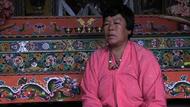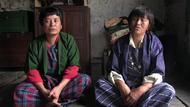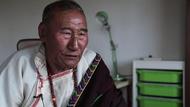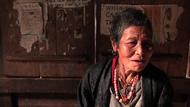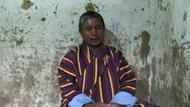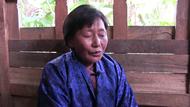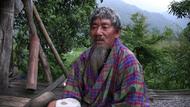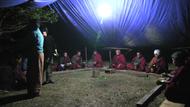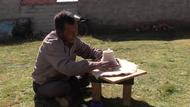Video Overview
An oral commentary explaining each of the nine ways of Bön based on the Gal mdo.
- བོན་གྱི་ཐེག་པ་རིམ་པ་ཟེར་མཁན་དེ་ལ་ག་ཚོད་ཡོག་རེད་ཟེར་ན།If asked, how many ways are there in Bön tradition?
- རྒྱུ་ཡི་ཐེག་པ་བཞི་བྱས། འབྲས་བུའི་ཐེག་པ་བཞི། རྒྱུ་འབྲས་དབྱེར་མེད་ཁྱད་པར་མེད་པའི་ཐེག་པ་བྱས་བྱས་ལྟ་ཐེག་པ་དགུ་ལ་བརྩི་གི་ཡོག་རེད།There are divided into four causal ways, four ways of the result, and an indistinguishable one.
- ལྟ་དེའི་ནང་ནས་རྒྱུ་ཡི་ཐེག་པ་ཆ་བཞག་ན། ཕྱྭ་གཤེན་ཐེག་པ་བྱས་གཅིག་བྱས། སྣང་གཤེན་ཐེག་པ། འཕྲུལ་གཤེན་ཐེག་པ། (སྲིད་གཤེན་ཐེག་པ་)བཞི་བྱས།The four causal ways are Cha Shen Tekpa, Nang Shen Tekpa, Trul Shen Tekpa, and Sid Shen Tekpa.
- དེ་ནས་རྒྱུ་འབྲས། འབྲས་བུའི་ཐེག་པ་ལ་ཆ་བཞག་ན། དགེ་བསྙེན་གྱི་ཐེག་པ། དྲང་སྲོང་ཐེག་པ། ཨ་དཀར་ཐེག་པ། ཡེ་གཤེན་གྱི་ཐེག་པ་བཅས་བཞི།The four ways of the result are Ghenyen Tekpa, Drangsong Tekpa, Ahkar Tekpa, and Yeshen Tekpa.
- ལྟ་དེ་དག་རྒྱུ་དང་འབྲས་བུའི་ཐེག་པ་བརྒྱད་སྒང་ལ། རྒྱུ་འབྲས་དབྱེ་བ་མེད་པའི་ག་རེ་ཡོག་རེད་ཟེར་ན་བླ་མེད་ཐེག་པ་བྱས་བྱས་ཐེག་པ་དགུ་ལ་ངོས་འཛིན་བྱེད་ཀྱི་ཡོག་རེད་ཟེར།In addition to these four causes and four results, we have Lamed Kyi Tekpa, which doesn't belong to neither group. So generally, there are nine ways of Bön.
- ཐེག་པ་དགུ་དེ་ལ་ཆ་བཞག་ན་གཙོ་བོ་ཆ་བཞག་སོང་ན་གང་འདྲ་སེ་ངོས་འཛིན་བྱེད་ཀྱི་རེད་ཟེར་ན།For these nine ways of Bön, how we define each of them?
- ཐེག་པ་རེ་རེ་ལ་འཇུག་པའི་སྒོ། བཅོས་པའི་ལས། རྟོགས་པའི་ལྟ་བ་བྱས་བྱས་གསུམ་ལ་དབྱེ་བ་ཕྱེ་གི་ཡོག་རེད།Each way has three parts, namely juk pé go, chö pé lé, and tok pé tawa.
- འོ་ལྟ་དཔེར་ན་ཆ་བཞག་སོང་ན། དང་པོ་དཔེར་ན་ཕྱྭ་གཤེན་ཆ་བབཞག་སོང་། ཕྱྭ་གཤེན་ཐེག་པ་ལ་ཆ་བཞག་སོང་ན། འཇུག་པའི་སྒོ་ཟེར་མཁན་དེ་གང་འདྲ་ཞིག་ལ་ཟེར་གྱི་རེད་ཟེར་ན། ལྟ་དཔེར་ན་ "གཏོ་དང་བཅས་ཀྱིས་སྒོ་ནས་འཇུག་པ་སྟེ་དེ་ལ་ཇི་ལྟར་འཇུག་པ་ན། སྤྱིར་སེམས་ཅན་རྣམས་གདོན་ལས་སོགས་པའི་ངན་གྲོགས་མང་དུ་བྱུང་སྟེ། དེ་མོ་དང་གཏོའི་སྒོ་ནས་སེལ་བར་འཇུག་པ་" ཟེར།For example, in the case of Cha Shen Tekpa, let me begin with its juk pé go. The definition says, "To dang ché kyi go né juk pa té dé la ji tar juk pa na. Chir sem chen nam dön lé sok pé ngen drok mang du jung té. Dé mo dang tö go né selwar juk pa."
- ལྟ་ག་རེ་ཟེར་གྱི་ཡོག་རེད་ཟེར་ན། གཙོ་བོར་དོན་དག་ག་རེ་ཟེར་གྱི་ཡོག་རེད་ཟེར་ན། ལྟ་སེམས་ཅན་མང་པོ་ཞིག་ལ་ཆ་བཞག་སོང་ན། ལྟ་གང་ལྟར་གདོན་ཞུགས་དུས་ཙམ་ལ། ལྟ་གདོན་ཟེར་མཁན་དེ་ཞུགས་དུས་ཙམ་ལ་དེ་ལ་འཇུག་པའི་སྒོ་གང་འདྲ་བཤད་ཀྱི་ཡོག་རེད་ཟེར་དུས་ཙམ་ལ། མོ་གཏོ་ཟེར་དུས་ཙམ་ལ་མོ་རྒྱག་ག་དང་གཏོར་མཆོད་བྱས་པ། ཡང་མིན་ན་གདོད་དང་སླུད་འོ་འདི་འདྲས་ལ། ཡང་མིན་ན་ནད་བྱུང་བ་ཡིན་ན། སྨན་དཔྱད་བརྟག་སྲེད་ཀྱི་སྒོ་ནས་དེ་གས་གང་ག་ལོགས་གདོན་དང་ནད་མེད་པ་བཟོས་པ་གཅིག་ལ་གང་ཟེར་གྱི་རེད་ཟེར་ན་འཇུག་པའི་སྒོ་རེད། ཕྱྭ་གཤེན་གྱི་སྒོ་འདི་རེད་ཟེར་ལྟ།What does that mean? Here the main point is this, for many animals, when they are possessed by dön [evil spirit] or suffering from serious illness, the juk pé go in such case is freeing oneself from the evil spirit by using divination and ritual or treating the illness with medical remedies. That is the juk pé go for Cha Shen.
- ལྟ་བཅོས་པའི་ལས་ཆ་བཞག་ན་ག་རེ་ཟེར་གྱི་ཡོག་རེད་ཟེར་ན། ཨཱ་ནི་བཅོས་པའི་ལས་དེ་གང་རེད་ཟེར་ན། "ནད་དང་གདོན་ལས་རྒྱུགས་པ་དེ་དག་ལས་དང་པོ་ཅི་ཉིད་རང་དང་གདོན་སྤྱི་ཇི་ལྟར་འཇུག་པ་སྟེ།" ལྟ་དཔེར་ན་ནད་ལ་ཆ་བཞག་སོང་ན་རྩ་ཆུའི་སྒོ་ནས་བརྟག་པ།Now, what is the chö pé lé in this case? The text said, "Né dang dön lé gyuk pa dé dak lé dang po chi nyi rang dang dön chi ji tar juk pa." For example, in the case of an illness, one can make a diagnosis by reading pulse and doing a urine analysis.
- ལྟ་སོ་སོ་ལ་དཔེར་ན་ཆ་བཞག་ན་གདོན་བྱུང་སོང་ན། གདོན་ལ་ཆ་བཞག་སོང་ན། གདོན་དེ་གང་འདྲ་བྱས་བྱས་བཅོས་ཐབས་དེ་གང་འདྲ་བྱེད་ཀྱི་ཡོག་རེད། ནད་ལ་ཆ་བཞག་སོང་ན་ལྟ་རྩ་དང་ཆུ་རེག་པ་འདི་འདྲ་བྱས་བྱས་ལྟ་གང་ལྟར་བོད་སྨན་ལ་ཆ་བཞག་སོང་ན། འོ་འདི་འགས་ཀྱིས་རྩ་ཆུ་བརྟག་པ་རེག་པ་འདི་འདས་ཀྱིས་གང་ལྟར་ནད་ལ་ཆ་བཞག་སོང་ན། ནད་རིགས་༣༦༠གང་ག་ལོགས་བརྩད་ཆོད་ཐུབ་པ་གཅིག་ལ་འདི་འདྲ་ཞིག་ལ་གང་ཟེར་གྱི་ཡོག་རེད་སྨན་དཔྱད་རྟོགས་ནས་ལྟ་གང་ལྟར་ནད་ཡིན་ནའང་འདྲ། གདོན་ལ་ཆ་བཞག་སོང་ན་འདུལ་ཐབས་འོ་འདི་འདྲས་བྱས་ཀྱི་ཐོག་ནས་བཅོས་པའི་ལས་སེ་འོ་འདི་འདྲ་ཞིག་ལ་ཟེར་གྱི་ཡོག་རེད།Likewise, if you are harmed an evil spirit, you will try to find a solution for that. In case of an illness, you make a diagnosis of the disease by feeling the pulse and doing a urine analysis. The ability to identify an illness from 360 kinds of diseases through medical examination and treating it or finding a treatment for harm caused by an evil spirit is called chö pé lé.
- དེ་ལ་ཆ་བཞག་སོང་ན་རྟོགས་པའི་ལྟ་བ་སེ་གང་འདྲ་ཞིག་ལ་ཟེར་གྱི་ཡོག་རེད། རྟོགས་པའི་ལྟ་བ་དེ་དཔེར་ན་ཆ་བཞག་སོང་ན་ལ་གའི་སོ་པས་འདི་ནང་ལ་དཔེ་ཆ་འདིའི་ནང་ལ་ཆ་བཞག་སོང་ན་ལུང་འདུག་སེ་དྲངས་འདུག་ག རྟོགས་པའི་ལྟ་བ་ནི་ "ལ་གའི་སོ་པས་དགྲ་འཇིགས་པ་ཐམས་ཅད་མཐོང་པ།" ལྟ་གང་ལྟར་མཐོ་པོ་ཞིག་གི་སྒང་ལ་བསྡད་བྱས་ཨཱ་ནི་འོག་ལ་ག་རེ་བྱེད་ཡོད་མེད་གང་ག་མཐོང་པ་ནང་ལྟར་ལྟ་འདི་ཟེར་གྱི་ཡོག་རེད།Now what is tok pé tawa for it? Citing from this source, it says, "La gé so pé dra jik pa tam ché tong pa." It means when someone sit on the top of something, that person can see everythng below it.
- ལྟ་འདི་ད་ལྟ་ངས་འདུག་སེ་གོང་དུས་ཞུས་པ་ནང་ལྟར་རེད། ཐེག་པ་གཅིག་ལ་ཆ་བཞག་སོང་ན་འཇུག་པའི་སྒོ་བྱས། བཅོས་པའི་ལས་བྱས། དེ་ནས་རྟོགས་པའི་ལྟ་བ་བྱས་ཐེག་པ་རེ་རེ་ལ་གསུམ་གསུམ་ཡོག་རེད། གསུམ་དེ་གང་རེད།Like what I said to you before, each way has three parts, namely juk pé go, chö pé lé, and tok pé tawa.
- འཇུག་པའི་སྒོ་སེ་གང་རེད་ཟེར་གྱྱི་ཡོག་རེད་ཟེར་ན། གང་འདྲ་ཞིག་ལ། འོ་འཆར་གཞི་གང་འདྲ་ཞིག་ལ་གང་འདྲ་སེ་འགྲོ་དགོས་ཀྱི་རེད། ལྟ་འོ་ན་འཇུག་པའི་སྒོ་བྱས་འོ་ལྟ་ལམ་ག་འདི་རེད་ཟེར། ལྟ་འཇུག་པའི་ལས་དེ་གང་འདྲ་རེད་ཟེར་ན། ལྟ་སྒོ་དེའི་འཛུལ་བ་ལ་ལས་ཀ་ག་རེ་བྱེད་དགོས་ཀྱི་རེད་ཟེར་གྱི་ཡོག་རེད།So what is juk pé go for it? It tells us what route we need to take, or shows us the way or the solution. It tells us what work we need to do when we enter the door.
- ལྟ་འོ་ན་རྟོགས་པའི་ལྟ་བ་སེ་ག་རེ་ཟེར་གྱི་ཡོག་རེད་ཟེར་ན། ལྟ་འདི་ནང་འཛུལ་ནས་ག་རེ་རྟོགས་དགོས་ཀྱི་ཡོག་རེད་འོ་འདི་བཤད་ཀྱི་ཡོག་རེད། ཐེག་པ་རེ་རེ་ལ་ཆ་བཞག་སོང་ན། སྣ་ག་གསུམ་དེ་འོ་འདུག་སེ་བྱས།Now, what is tok pé tawa here? It's once we entered the door, what we need to understand. So that is what it is telling us. Like that, each way has three parts.
- ལྟ་འ་ལྟ་ངས་གོང་དུ་ཞུས་པ་དེ་ལ་ཆ་བཞག་སོང་ན་ལྟ་འདི་རེད་པ། ཕྱྭ་གཤེན་གྱི་ཐེག་པ། ཕྱྭ་གཤེན་གྱི་ཐེག་པ་དེ་ལ་ད་ལྟ་འདུག་སེ་བཤད་ཚར་སོང་ང་། ཕྱྭ་གཤེན་གྱི་ཐེག་པ་ལ་གཙོ་བོ་དེ་གང་རེད་ཟེར་ན་མོ་དང་གཏོ། འོ་མོ་གཏོ་ཁག་ནས་འདིའི་མོ་དང་གཏོར་གྱི་གང་ནས་ཨཱ་མི་ཧ་གོ་པ་བྱས། ལྟ་འཇུག་པའི་ལས་དེ་གང་རེད་ཟེར་ན་མོ་དང་གཏོ་བྱས། ལྟ་དེ་ལ་བརྟེན་ནས་མདུན་ཐབས་དེ་ལ་བརྟེན་ནས་ནད་རིགས་༣༦༠དང་གདོན་དང་གང་ག་ལོགས་གདོན་ལུགས་བཅོས་པའི་ཁོ་ལས་དེ་བྱས།The example I just have to give you is Cha Shen Tekpa. In its case, it mainly relies on divination and exorcizes ritual to understand the cause, and that's its juk pé lé [go]. By relying on such methods and treating the 360 different kinds of harm caused by an evil spirit or others, then that is the chö pé lé for this way.
- རྟོགས་པའི་ལྟ་བ་དེ་གང་རེད་ཟེར་ན། ལྟ་ན་ཚ་དེ་ཡིན་ནའང་འདྲ། གདོན་གེགས་ག་རེ་ཡིན་ནའི་སོ་སོ་མཐོ་པོ་ཞིག་གི་སྒང་ནས་བསྡད་བྱས་མར་མཐོང་ཐུབ་འོ་ཨེ་འདྲས་བྱས་ཤིག་ལ་འོ་ལྟ་འདི་འདྲས་ཤིག་ལ་ལྟ་དཔེར་ན་སྣང་གཤེན་གྱི་ཐེག་པ། ཨཱ་ཕྱྭ་གཤེན་གྱི་ཐེག་པ་བྱས་བྱས་ལྟ་ཐེག་པ་དང་པོ་དེ་རེད། འོ་ཐེག་པ་དང་པོ་དེ། བོན་གྱི་ཐེག་པ་རིམ་དགུའི་ནང་ནས་ཐེག་པ་དང་པོ་དེ་བྱས།And what is its tok pé tawa? Be it a disease, harm caused by an evil spirit, or whatever it is, if you can have a bird's eye view from a vantage point, it is called Cha Shen Tekpa. It's the first way from the nine ways of Bön.
- ལྟ་ཐེག་པ་གཉིས་པ་དེ་ལ་ཆ་བཞག་སོང་ན་སྣང་གཤེན་གྱི་ཐེག་པ་ཟེར་མཁན་དེ་རེད། སྣང་གཤེན་གྱི་ཐེག་པ་ཟེར་མཁན་དེ་ཆ་བཞག་སོང་ན་ལྟ་གོང་དུ་ཞུས་པ་ལྟར་ད་ག་རང་རེད། འཇུག་པའི་སྒོ། བཅོས་པའི་ལས། རྟོགས་པའི་ལྟ་བ་བྱས་བྱས་གསུམ་འདུག་སེ་དབྱེ་གི་ཡོག་རེད།The second way is Nang Shen Tekpa. Like the previous way, it has three parts, namely juk pé go, chö pé lé, and tok pé tawa.
- ལྟ་འཇུག་པའི་སྒོ་ལ་འདུག་སེ་ཆ་བཞག་སོང་ན་གང་འདྲ་ཞིག་ལ་ཟེར་གྱི་ཡོག་རེད་ཟེར་ན། "གྱེར་སྒོ་བཞི་དང་སྐད་གཅོང་དགུ། གཏང་རག་བཞི་བཅུ་རྩ་གཉིས་ཀྱིས་འཇུག་པའི་སྒོ་སྟེ།" གྱེར་སྒོ་བཞི་ཞེས་གང་ཟེར་གྱི་ཡོག་རེད་ཟེར་ན། གྱེར་སྒོ་བཞི་ཞེས་གང་ཟེར་དེ། གྱེར་སྒོ་བཞི་བྱས་སྐད་གཅོང་དགུ་བྱས་གཏང་རག་བཞི་བཅུ་རྩ་གཉིས་བྱས་བྱས་འདི་གས་ཁོ་ཚོའི་ལྟ་ལས་ཀ་བྱེད་ཡག་གི་གཞི་འདི་རེད་ལྟ།So what is the juk pé go in this case? The text says, "Gyer go zhi dang ké chong gu tang rak zhi chu tsa nyi kyi juk pé go té." What is the meaning of 'gyer go zhi'? The phrases like gyer go zhi, ké chong gu, and tang rak zhi chu tsa nyi are the basis of one's actions.
- ལྟ་འདིའི་ནང་ལ་ག་རེ་འགྲེལ་བཤད་བརྒྱབ་ཡོག་རེད་ཟེར་ན། གྱེར་སྒོ་བཞི་ཞེས་གང་ཟེར་གྱི་ཡོག་རེད་ཟེར་ན། མཐར་དང་སླུད་ཀྱི་འོ་འདི་འདྲ་ཞིག་ལ་ཕྱ་གཉེན་གྱི་སྒོ། གྱེར་སྒོ་བཞི་ལྷ་གསས་མཆོད་པའི་སྒོ་དང་། སེལ་དང་ཁྲུས་ཀྱི་སྒོ། ཐར་དང་གླུད་ཀྱི་སྒོ། ཕྱ་གཡང་གཉན་གྱི་སྒོ། འོ་འདི་གས་ག་རེ་རེད་ཟེར་ན་གྱེར་སྒོ་བཞི་ཟེར་མཁན་དེ་འོ་འདི་རེད།In this text, it told us what are the ger go zhi or four ger go. They are: Lha sé chö pé go, Sel dang trü kyi go, Tar dang lü kyi go, and Cha yang nyen gyi go.
- སྐད་གཅོང་དགུ་ཟེར་མཁན་དེ་གང་རེད་ཟེར་ན། དང་པོ་ལས་གསུམ། བར་དུ་ལས་གསུམ། མཐའ་མ་ལ་བཞག་པ་གསུམ་བྱས། ཨཱ་ནི་འདི་གས་ལ་གང་ཟེར་གྱི་རེད་ཟེར་ན། ལྟ་གང་ལྟར་འདི་ཟེར་གྱི་ཡོག་རེད་སྐད་གཅོང་དགུ་ཟེར་མཁན་དེ་འོ་འདུག་སེ་རེད།Now, what are the nine ké chong? They are three lé in the beginning, three lé in the middle, and three at the end. These are the nine ké chong.
- དང་པོ་དྲངས་པ་ལ་གསུམ། བར་དུ་སྒྲུབ་པ་ལ་གསུམ། མཐའ་མ་བཞག་པ་ལ་གསུམ་བྱས་ལྟ་འདི་གས་གང་ཟེར་གྱི་རེད་ཟེར་ན་སྐད་གཅོང་དགུ་བྱས།Or we can say, in the beginning, there are three drang pa, three drup pa in the middle, and three zhak pa at the end. They are together called the nine ké chong.
- གཏང་རག་བཞི་བཅུ་རྩ་གཉིས་ཟེར་མཁན་དེ་གང་རེད་ཟེར་ན། ལྷ་གསས་མཆོད་པའི་སྒོ་ལ་བཅུ་བྱས། སེལ་གྱི་ཁྲུས་ཀྱི་སྒོ་ལ་འཇུག་པ་བཅུ་བྱས། ཐར་དང་གླུད་འཇུག་པ་བཅུ་བྱས། ཕྱ་དང་གཡང་ལ་བཅུ། གཉན་དང་སེལ་པ་བཅུ་རེད་འདའི་འདི་གས་བསྡོམས་ལ་གང་ཟེར་གྱི་ཡོག་རེད་ཟེར་ན། བཞི་བཅུ་རྩ་གཉིས་ཟེར་དུས་བཞི་བཅུ་རྩ་གཉིས་ཅེས་དོན་དག་རྡོག་རྡོག་གང་ཟེར་གྱི་ཡོག་རེད་ཟེར་ན། བཞི་བཅུ་རྩ་གཉིས་ཟེར་དུས་ཙམ་ལ་བཞི་བཅུ་ཞེ་གཉིས་ཟེར་གྱི་ཡོག་རེད། འོ་ལྟ་ད་ག་རེད། འོ་ཨེ་འདྲས་ཤིག་ལ་བཤད་ཀྱི་ཡོག་རེད།Now the next one is forty-two tang rak. They are: ten lhasé chöpé go, ten selgyi trü kyi go, ten tar and lü juk pa, ten cha and yang, and ten nyen and selpa. Here 'zhi chu tsa nyi' means forty-two.
- ལྟ་འདི་ཆ་བཞག་སོང་ན་སྣང་གཤེན་གྱི་འདི་རེད་འཇུག་པའི་སྒོ་དེ་རེད། ང་ཚོ་མ་སོང་ནའི་ལས་པ་བྱེད་ཀྱི་བྱེད་ཡུལ་དེ་རེད། འོ་བྱེད་ཡག་གི་ཡུལ་དེ་རེད།That is juk pé go for Nang Shen Tekpa. In our everyday language, it is the object of an action.
- འདི་ལ་ཆ་བཞག་སོང་ན། ལྟ་དེ་ལྟར་གྱི་རྐྱེན་པས་གཏང་རག་འདི་བྱས་བྱས་ལྟ། ལྟ་འདི་བྱེད་པའི་ཡུལ་དེ་འོ་འདྲས་ཤིག་ལ་སླེབས་དུས་ཙམ་པ། བཅོས་པའི་ལས་དེ་གང་འདྲ་སེ་བྱེད་དགོས་ཀྱི་རེད་ཟེར་ན། བྱེད་པའི་ཡུལ་འདི་ལ་ཆ་བཞག་སོང་ན་བཅོས་པའི་ལས་ག་རེ་བྱེད་དགོས་ཀྱི་རེད་ཟེར་ན། ལྟ་བཅོས་པའི་ལས་འདི་ནི་ག་རེ་ཟེར་གྱི་ཡོག་རེད་ཟེར་ན། "སྣང་བཞིན་སྲིད་པ་ཐམས་ཅད་ལྷ་དང་འདྲེ་རུ་གནས་གེགས་སྟོང་ཕྲག གེགས་རིགས་སྟོང་ཕྲག་བརྒྱད་བཅུ་དང་། ལྷག་མ་སྡེ་སྲིན་བརྒྱད། སྔོན་གནས་ཀྱི་ལམ།" སྔོན་གནས་ཀྱི་ལམ་ཟེར་དུས་ཙམ་ལ་ལྟ་སྔས་མའི་ལམ། འཕྲལ་དང་ད་ལྟ་ཐུག་དང་རྒྱུགས་པའི་ལམ། "དགོས་མཁོ་རྙེད་པའི་ཡོན་བདག་ལ་སྐྱབས་མཛད། ཨཱ་ནི་བར་དུ་གེགས་གླུད་ཕུལ་ཞིང་བཏབ་པ་"འོ་ཨེ་འདྲས་ཤིག་ལ་གང་ཟེར་གྱི་ཡོག་རེད་ཟེར་ན། དེ་འཕྲལ་ཆེད་དུ་མགོ་སྲིན་ནས་བྱས་མར་མནན་པ་འོ་ཨེ་འདྲས་ཤིག་ལ་རང་གི་འདོད་པ་བཞིན་དུ་སྐོངས་པ་ཞིག་ལ་ག་རེ་ཟེར་གྱི་ཡོག་རེད་ཟེར་ན་ལྟ་སོ་སོའི་བཅོས་པའི་ལས་དེ་རེད། བཅོས་པའི་ལས།So that is about the object of action. Now how you perform the task, the chö pé lé in this case? The text says, "Nang zhin si pa tam ché lha dang dré ru né gek tong trak. Gek rik tong trak gyé chu dang, lhak pa dé sin gyé, ngön né kyi lam. Gö kho nyé pé yön dak la kyap dzé a ni bar du gek lü pül zhing tap pa." Here 'ngön né kyi lam' means a pre-existing path. Serving your patron that provided your needs and performing lü ritual, like that, doing what you like is the chö pé lé for the way.
- ལྟ་བཅོས་པའི་ལས་རྡོག་རྡོག་ཏུ་བཤད་སོང་ན་ག་རེ་བཤད་ཀྱི་ཡོག་རེད་ཟེར་དུས་ཙམ་པ་འདི་ནང་གཙོ་བོ་ག་རེ་བཤད་ཀྱི་ཡོག་རེད་ཟེར་ན། ང་ཚོ་ལ་འ་ལྟ་དཔེར་ན་ཆ་བཞག་སོང་ན་བླ་འགུགས་ཚེ་འགུགས་བྱེད་པར་ལྟ་འདི་འ་ལྟ་སྣང་གཤེན་དེ་བཅོས་པའི་ལས་འཇུག་པ་ལ་ཆ་བཞག་སོང་ན་ག་རེ་བྱེད་དགོས་ཀྱི་རེད་ཟེར་ན་བླ་འགུགས་ཚེ་འགུགས་བྱེད་ཡག ཚེ་དབང་ཚེ་སྒྲུབ་བྱེད་ཡག ཡང་མིན་ན་སོ་སོའི་ཚེ་འཕེལ་བའི་ཆེད་དུ་ལས་པ་བྱེད་པ་འོ་འདི་འདྲས་ཤིག་ལ་ག་རེ་ཟེར་གྱི་ཡོག་རེད་ཟེར་ན་ལྟ་སྣང་གཤེན་གྱི་བཅོས་པའི་ལས་དེ་རེད།In brief, here chö pé lé mainly means, as we have ritual practices such as summoning the bla or gathering back life energy, in the, case of Nang Shen Tekpa, the chö pé lé for it is performing rites to summon the bla or life-energy.
- ལྟ་རྟོགས་པའི་ལྟ་བ་དེ་གང་འདྲ་ཞིག་ལ། ལྟ་སྣང་གཤེན་གྱི་རྟོགས་པའི་ལྟ་བ་ག་རེ་ཟེར་གྱི་རེད་ལྟ་གཙོ་བོ་རེ་དེ་ག་རེ་བཤད་ཀྱི་ཡོག་རེད་ཟེར་ན། ཨཱ་ནི་གཙོ་བོ་ར་རེད། ལྟ་གཏང་རག་བཅུ་བཞི་དང་ད་ལྟའི་མདུན་གྱི་དོན་དག་རྡོག་རྡོག་འདི་གས་གང་ག་སྐད་བཅོ་བརྒྱད་གཏང་རག་བཞི་བཅུ་རྩ་གཉིས། འདི་འདྲས་གང་ག་ལོགས་དོན་དག་ཚང་མ་སོ་སོའི་ཀླད་པའི་ནང་ལ་བླུགས་བྱས་སོ་སོས་ག་དར་ཆོད་པ་བྱས་བྱས་གང་འདྲ་ཞིག་ལ་ཟེར་གྱི་ཡོག་རེད་ཟེར་ན་སོ་སོ་སོའི་འགྲོ་བ་རིགས་དྲུག་སེམས་ཅན་ཐམས་ཅད་བདེ་བར་འཁོད་ཐུབ་པ་བྱས། ཨཱ་ནི་འོ་འདི་འདྲས་ཤིག་ལ་འདི་ཟེར་གྱི་ཡོག་རེད། ལྟ་འདི་སྣང་གཤེན་གྱི་རྟོགས་པ་འདི་འོ་འདི་རེད། རྟྲོགས་པ་རྟོགས་པ་ཟེར་དུས་བྱ་བ་ཚང་མ་བྱས་བྱས་སོ་སོའི་ཀླད་པའི་ནང་ལ་བླུགས་ཐུབ་ན་ཨཱ་ནི་བྱ་བ་དེ་ལ་ག་དར་ཆོད་པ་ཟེར་དུས་ང་ཚོ་དང་མ་སོང་ནའི་བཅུན་བྱས་ལས་ཀ་འདི་བྱས་ནས་འདི་བྱེད་པ་ལྟ་བུ་སོ་སོ་སོའི་རྟོགས་པ་སྐྱེས་ཐུབ་པ་འོ་ཨེ་འདྲ་ཞིག་ལ་ལྟ་འདི་བཤད་ཀྱི་ཡོག་རེད།Now, what is tok pé tawa for it? What is tok pé tawa for Nang Shen? The main point is this, for example, the fourteen tangrak and the other things I mentioned before such as ké cho gyé and tang ak zhichu tsanyi, if you keep them in your mind and understand their meanings, and putting all the living being in a comfortable position, then that is Nang Shen's tokpa. Here 'tokpa' means if you perform all the tasks and able keep them in your mind, you gain insight and become adept at it, that's it.
- ལྟ་འདི་རེད་གང་ཟེར་དགོས་ཀྱི་རེད། ཐེག་པ་རིམ་དགུ་ནང་ནས་དང་པོ་ཕྱྭ་གཤེན་བྱས། ལྟ་གཉིས་པ་སྣང་གཤེན་རེད།From the nine ways of Bön, the first one is Cha Shen and the second one is Nang Shen.
- འོ་ལྟ་གསུམ་པ་ལ་ཆ་བཞག་སོང་ན་འཕྲུལ་གཤེན་རེད་འདུག་ག ལྟ་འཕྲུལ་གཤེན་གང་འདྲ་ཞིག་ལ་ཟེར་གྱི་ཡོག་རེད་ཟེར་ན། ལྟ་འཕྲུལ་གཤེན་ལ་ད་ལྟ་གོང་དུ་ཞུས་པ་ནང་ལྟར་རེད། ལྟ་ཆ་བཞག་སོང་ན་འཇུག་པའི་སྒོ། བཅོས་པའི་ལས། རྟོགས་པའི་ལྟ་བ་བཅས་རིམ་པ་གསུམ། ལྟ་འདི་ཐེག་པ་རིམ་དགུ་ཚང་མར་ལ་ལོགས་ལ་ད་ག་རང་ཡོག་རེད་ལྟ།Now the third one is Trul Shen. Here, what is Trul Shen now? As I mentioned earlier, Trul Shen also has the same three parts, namely juk pé go, chö pé lé, and tok pé tawa. These three parts are common to all the nine ways of Bön.
- ལྟ་འཕྲུལ་གཤེན་ལ་ཆ་བཞག་སོང་ན། འཇུག་པའི་སྒོ་ལ་ཆ་བཞག་སོང་ན་གང་འདྲ་ཞིག་ལ་ཟེར་གྱི་ཡོག་རེད་ཟེར་ན། ཐབས་དང་རྫུ་འཕྲུལ་ཡང་གསུམ་གྱི་སྒོ་ནས་གཡུང་དྲུང་བོན་གྱི་བསྟན་པ་ལ་གསང་པའི་ཐབས་སུ་གསང་བ་ཟེར་དུས་ཙམ་པ་འདི་ནང་དོན་དག་ག་རེ་དྲོངས་བའི་དོན་དང་བསྟན་པ་སྐྱོངས་བའི་དོན་ལ་གོ་གི་ཡོག་རེད། ལྟ་རོགས་པ་བྱེད་པའི་དོན།In the case of Trul Shen, the juk pé go is "tap dang dzuntrül yang sum gyi go né yung drung bön gyi ten pa la sang pé tap su sangwa." Here in this line, the word 'sangwa' means drong or to serve the teachings of the Bön. It means to help.
- ལྟ་"འཇིགས་པའི་ལྷ་འདྲེ་མི་གསོན་པོ་གང་འདྲ་ཞིག་ཡོད་པ་ཡིན་ནའི། འདི་འདྲའི་ཤ་ཁྲག་ལ་སོགས་པའི་དགོས་པའི་ཡོ་ཆས།" ཤ་ཁྲག་ལ་སོགས་པའི་དགོས་པའི་ཡོ་ཆས་ཟེར་དུས་ཙམ་ལ་ལྟ་ཡང་འདའི་དེ་ལ་ཡིན་གཅིག་གིས་དམར་མཆོད་གལ་དགོས་ཡག་ཡོག་མ་རེད།"Jik pé lha dré mi sön po gang dra zhik yö pa yin né. Dindré sha trak la sok pé gö pé yo ché." Here 'sha trak la sok pé gö pé yo ché' not necessarily means to make a red offering.
- ལྟ་འདའི་མི་ཁོ་ག་རེ་དགོས་ཀྱི་ཡོག་རེད་ཟེར་ན་ལྟ་ཁོ་མཚོན་རྟགས་ཀྱི་དངོས་པོ་ཨེ་འདྲས་ཆོག་ཏོ་ཡོག་རེད། འོ་ཨེ་འདྲས་ར་ཅིག་བྱས་བྱས་ཨཱ་ནི་ལྟ་གང་ལྟར་ལྟ་འདྲ་འདི་འདྲ་གང་ག་ལ། "ལྷ་དང་བདུད་དང་སྲིན་པ་གང་ག་བྲན་དུ་བཀོལ་བ་"ཟེར་དུས་ཙམ་ལ་སོ་སོས་བཀོལ་སྤྱོད་བྱས་པ་དེ་ཚོ་ལ་ཟེར་དགོས་ཀྱི་ཡོག་རེད་ལྟ། བཀོལ་སྤྱོད་བྱེད་ཐུབ་པ་རྡོག་རྡོག་ག་རེ་ཟེར་གྱི་ཡོག་རེད་ཟེར་ན་རང་གིས་དབང་དུ་བསྡུས་ནས།What it tells us is that there are many symbolic things. And "lha dang dü dang sin pa gang ga dren du kölwa" means conquering and making gods and spirits to serve your interests.
- དཔེར་ན་ལྷ་ཡིན་ནའི་འདྲ། འདྲེ་ཡིན་ནའི་གང་འདྲ་ཞིག་ལ་ཆ་བཞག་སོང་ན། "ཁྱོད་རས་ངའི་ལས་ཀ་འདི་བྱེད་ཨ། ངས་ཁྱོད་རར་འདི་བྱེད་" ཟེར་དུས་ཁོས་ "ལགས་སོ་" བྱས་བྱས་བཀའ་ལ་བཀུག་ཐུབ་པ་ཞིག་ལ་བཀོལ་སྤྱོད་བྱེད་པ་ཟེར་གྱི་རེད། འདི་འདྲས་སེ་སྲུང་མ་དམ་ལ་བཏགས་པའི་དོན་དག་གཅིག་ལ་བཤད་ཀྱི་ཡོག་རེད་དེ།For example, be it god or spirit, suppose you tell them, "You perform this task for me." And they reply to you and say, "I will." That is the meaning of the word 'köl chö,' to make someone to work for you. That is binding the spirit under oath.
- ལྟ་དཔེར་ན་ལྷ་འདྲེ། ལྷ་ཡིན་ནའི་འདྲ་འདྲེ་ཡིན་ནའི་འདྲ་སོ་སོར་གནོད་པ་སྐྱེལ་གྱི་ཡོད་ན་'འཁོལ་དུ་བཀོད་པ་'ཟེར་དུས་ཙམ་ལ་སོ་སོའི་དབང་དུ་བསྡུས་པ་ཞིག་ལ་བཤད་ཀྱི་ཡོག་རེད། འོ་འདི་འདྲས་བྱས་ལྟ་འདིས། For instance, be it a god or a spirit that harms you, if you can bring them under your control, then it is called 'khöl du kö pa.' That's what it is telling.
- ལྟ་འདིའི་ནང་དཔེར་ན་ཆ་བཞག་སོང་ན། ལྟ་འདི་གཙོ་བོ་ར་ཅིག་ཆ་བཞག་སོང་ན་གང་འདྲ་ཞིག་ལ་བཤད་ཀྱི་ཡོག་རེད་ཟེར་ན་ "བསྟན་པ་སྤེལ་ཞིང་། བསྟན་པའི་ཆ་ཐུན་མོང་པའི་ལྟ་གང་ལྟར་རིག་གནས་སོ་སོ་སོའི་འདི་འདྲས་བྱས་བྱས་འཇུག་པའི་སྒོ་" བྱས་ལྟ་ད་ག་རང་རེད། ཐུན་མོང་མ་ཡིན་པའི་སོ་སོའི་རྩལ་དང་རིག་ལ་བརྟེན་ནས་གང་ལྟར་བླ་མ་ཡིན་ནའི་འདྲ་ག་རེ་ཡིན་ནའི་དེའི་རྟོགས་པ་ལ་བརྟེན་ནས་ཨཱ་ནི་ལྷ་དང་འདྲེ་གནོད་པ་སྐྱེལ་མཁན་སོ་སོའི་བྲན་དུ་འཁོལ་ཐུབ་པ། 'བྲན་དུ་འཁོལ་ཐུབ་པ་' ཟེར་དུས་གཡོག་ཏུ་བཀོལ་ཐུབ་པ་དམ་དུ་བཏགས་ཐུབ་པ་འོ་ཨེ་འདྲས་ཤིག་ལ་གོ་དགོས་ཀྱི་རེད། འོ་འདི་ཆ་བཞག་སོང་ན་འཇུག་པའི་ལས་འདི་རེད།In this text, for example, it's what it says, "Ten pa pel zhing ten pé cha tün mong pé ta gang tar rik né so so sö dindré jé jé juk pé go." It means by using your intelligence and relying on the realization of lama or others, you tame the god or spirit that harms you. Here 'dren du khöl tup pa' means to make them serve for you. And that's juk pé lé for the way.
- ལྟ་འདི་ནང་ནས་འཇུག་པའི་ལས་བྱས། དཔེར་ན་ཆ་བཞག་སོང་ན་བཅོས་པའི་ལས་ལ་ཆ་བཞག་སོང་ན་འོ་འདི་འདྲས་ར་ཅིག་རེད། "སྔགས་དང་ཕྱག་རྒྱ་ཏིང་ངེ་འཛིན་བྱས། ཕྱོ་ནས་མོ་དང་རྒྱལ་མོ་ཟིན་མ་ཐག མཐའ་མ་སྲོག་ལ་འཇིག་རྟེན་ལྷ་འདྲེ་དྲེགས་པ་ཅན་" སེ་འདུག་ག་འདའི། 'འཇིག་རྟེན་ལྷ་འདྲ་དྲེགས་པ་ཅན་' ཟེར་གནོད་པ་ཅན་འདི་གས་ཟེར་གྱི་ཡོག་རེད། ལྟ་ "བོན་ལ་མོས་ཤིང་གདུང་བ་དང་།" ལྟ་བོན་པོ་ལ་ག་རེ་ཡིན་ཟེར་ན་མོས་ཤིང་ཟེར་དུས་དད་པ་བྱེད་པ། གདུང་བ་དང་ཟེར་དུས་ཙམ་ལ་སོ་སོས་བློ་གཅིག་སེམས་གཅིག་གིས་བློ་གཏད་པ་འོ་ཨེ་འདྲས་གཅིག་ལ་གོ་དགོས་ཀྱི་རེད།That's about juk lé. Now as for chö pé lé, it's explained in the text like this, "Ngak dang chak gya ting ngé dzin. Cho né mo dang gyel mo zin ma tak. Ta ma sok la jik ten lha dré drek pa chen." Here in this line, 'jik ten lha dré drek pa chen' means the spirits that cause harms. And the line, "Bön la mö shing dungwa dang" means having faith in Bön. And the word 'dungwa' means fully trusting.
- འོ་ཨེ་འདྲས་ཤིག་བྱས་བྱས་དགྲ་བོའི་བླ་དག་ཁུག་མ་ཁུག་དང་། གྲོས་ལྟར་འདི་ཉམས་སུ་མྱོང་བ་བྱེད་པའི་བརྗོད་པ་འདི་ལ་ག་རེ་ཟེར་གྱི་ཡོག་རེད་ཟེར་ན་བཅོས་པའི་ལས། ལྟ་དཔེར་ན་ཆ་བཞག་སོང་ན་ "བསྟན་པ་སྤེལ་བའི་ཐབས་ཟེར་འོ། ལྟ་འདི་ལྷ་ཀླུ་མི་གསུམ་སེམས་སྐུལ་ཏེ་ཕན་བདེའི་གཞི་བྱེད་སངས་རྒྱས་ཀྱི་བསྟན་པ་ལ་གནས་ཤིང་བཅོས་པ་བྱའོ།" འོ་འདི་རེད་ལྟ།By doing something like that, whether you are able to conquer your enemy or not is chö pé lé. For example, the text says, "Ten pa pelwé tap zer o ta di lha lu mi sum sem kül té pen dé zhi jé sang gyé kyi ten pa la né shing chö pa jao." That's one.
- ལྟ་སངས་རྒྱས་ཀྱི་བསྟན་པ་ལ་ལྷ་ཀླུ་མི་གང་ག་བཀུག་བྱས་ལྟ་བོན་གྱི་བསྟན་པ་དེ་ལ་ག་རེ་བྱེད་ཀྱི་ཡོག་རེད་ཟེར་དུས་ཙམ་མ། བོན་གྱི་བསྟན་པ་ལ་ "དེ་རིང་ནས་བྱས་ངས་ཁྱོད་ར་བོན་གྱི་བསྟན་པ་དེ་ལ་མོས་གུས་ཡོད། དད་པ་ཡོད། ལྟ་དེ་རིང་བྱས་བྱས་བོན་གྱི་བསྟན་པ་དེ་སྲུང་གི་ཡིན། སྐྱོང་གི་ཡིན་" ཟེར་འོ་ཨེ་འདྲས་ཤིག་ལས་འཇུག་པ་དེ་ལ་ལྟ་འོ་འདི་བཤད་ཀྱི་ཡོག་རེད། འོ་འདི་བཅོས་པའི་ལས་རེད།It means taming all the gods and nagas and make them serve the Bön teachings. And make them take an oath and say, "From today onward, I have faith and trust in Bön teaching. And I am going to protect and serve them." That is what the text is telling us. And this is the chö pé lé for the way.
- ལྟ་རྟོགས་པའི་ལྟ་བ་ཆ་བཞག་སོང་ནའི་ད་ག་རེད། ལྟ་དཔེར་ན་ཆ་བཞག་སོང་ན། འཕྲུལ་གཤེན་ཐེག་པ་ཆ་བཞག་སོང་ན་རྟོགས་པའི་ལྟ་བ་ཡོག་རེད་པ། ལྟ་འདི་ལ་ཆ་བཞག་སོང་ན་ལྟ་ག་རེད་ཟེར་ན་འཕྲུལ་གཤེན་གྱི་ལྟ་བ་གྲུབ་ཚུལ་དེ་ལ་གང་ཟེར་གྱི་རེད་ཟེར་ན་ལྟ་དགེ་སྡིག་གི་སྐྱོན་ཡོན་ཏན། དགེ་བ་བསགས་ན་ཕན་པ་ཡོད་པ། ཨཱ་ནི་སྡིག་པ་བསགས་ན་སྐྱོན་ཡིན་པ། དགེ་བ་བསགས་ན་དགེ་ཡིན་པ། འོ་འདུག་སེ། འཆི་མི་རྟག སེམས་ཅན་ཐམས་ཅད་ལ་སོ་སོ་སོས། རྒྱུ་འབྲས། རྐྱེན། རྟེན་འབྲེལ་གང་ག་ལོགས་སོ་སོ་སོའི་སེམས་ནང་ཐུབ་པ་ཞིག་གང་འདྲ་ཟེར་གྱི་རེད་ཟེར་ན། འཕྲུལ་གཤེན་ཐེག་པའི་རྟོགས་པའི་ལྟ་བ་དེ་རེད།It is same as the case of tok pé tawa. For example, the Trul Shen Tekpa also has tok pé tawa. Right? The ideas behind Trul Shen Tekpa are that accumulating merits are beneficial while accumulating evil deeds wrong things to do. It also talks about death and impermanence. Thus if all the aminals could think of cause and effect, cause, interdependence, and all others, that is tok pé tawa for Trul Shen Tekpa.
- ལྟ་དེ་གང་རེད་ཟེར་ན་འཆི་མི་རྟག་ཧ་གོ་བ་བྱེད་དགོས་ཀྱི་རེད། ལས་རྒྱུ་འབྲས་ཤེས་པ་བྱེད་ཀྱི་ཡོག་རེད། ལས་རྒྱུ་འབྲས་ལ་བཟང་ངན་ཧ་གོ་ཐུབ་པ་བྱེད་དགོས་ཀྱི་རེད། འོ་འདི་འདྲ་གཅིག་ལ་ལྟ་སོ་སོའི་སེམས་ནང་དུ་ཨ་ལས་འདི་འདྲས་ཤིག་རེད་འདུག་ག་བསམས་པ་ཞིག་རྟོགས་པ་འདི་འཆར་བ་དེ་ལ་གང་རེ་ཟེར་ན་འཕྲུལ་གཤེན་གྱི་རྟོགས་པའི་ལྟ་བ་རེད།That is because efforts are put to comprehend the death and impermanence, cause and effect, and goodness or badness of cause and effect. If you could comprehend them in your mind, that is the comprehension of the Trul Shen.
- ལྟ་བཞི་པ་དེ་རྒྱུ་ཡི་ཐེག་པའི་གང་ལྟར། བཞི་པ་དེ་གང་རེད་ཟེར་ན་སྲིད་གཤེན་ཐེག་པ་ཟེར་མཁན་དེ་རེད། སྲིད་གཤེན་ཐེག་པ་ཟེར་མཁན། ལྟ་སྲིད་གཤེན་ཐེག་པ་ལ་ཆ་བཞག་སོང་ན། ལྟ་དཔེར་ན་ཆ་བཞག་སོང་ན་སྲིད་གཤེན་ཐེག་པ་ཟེར་དུས་ "ཤེས་ཐབས་བརྒྱད་བཅུ་རྩ་གཅིག དུར་སྒོ་བསྡུར་ཐབས་༣༦༠སྒོ་ནས་ལྟ་དེ་ལ་ཤེས་ཐབས་བརྒྱད་བཅུ་རྩ་གཅིག་ཟེར་མཁན་དེ་གང་འདྲ་ཟེར་གྱི་ཡོག་རེད་ཟེར་ན། ལྟ་དཔེར་ན་སྲིད་གཤེན་ཐེག་པ་ཟེར་ཡག་དེ་གཙོ་བོ་ག་རེ་བཤད་ཀྱི་ཡོག་རེད་ཟེར་ན། ཤི་ཡག་ལ་ཆ་བཞག་སོང་ན་སྣ་མིན་སྣ་ཚོགས་ག་ཚོད་ཡོད་མེད།The fourth way is Sid Shen Tekpa. For this way, the text says, "shé tap gyé chu tsa chik dur go dur tap 360 go né". Here what phrase 'shé tap gyé chu tsa chik' tell us is this, for example, in the case of Sid Shen Tekpa, the main point is it tells how many different kinds of death are there.
- ཚ་གྲང་གི་ཐོག་ནས་ག་ཚོད་ཡོད་མེད། འཐབ་རྩོད་ཀྱི་ཐོག་ནས་ཤི་བ་ག་ཚོད་ཆ་ག་ཚོད་ཡོད་མེད། གློ་བུར་དུ་ཤི་བ་ག་ཚོད། ཡང་མིན་ན་གྲིབ་ཤི་ཐེབས་པ་ག་ཚོད་ཡོད་མེད། འབྱུང་བའི་གནོད་པ་ཟེར་བ་ལྟ་འ་ན་དཔེར་ན་ཆ་བཞག་སོང་ན་འབྱུང་བའི་གནོད་པ་ཆ་བཞག་སོང་ན་མེ་ཆུ་ས་རླུང་འོ་འདི་འདྲ་ཞིག་གི་གནོད་པས་མི་གང་འདྲ་ཤི་པ་འདི་སྐོར་ནས་ལྟ་འདི་འཇུག་པ་སྒོ་འདི་བཤད་ཀྱི་ཡོག་རེད།It tells us how many kinds of deaths are there due to causes such as hotness or coldness, conflict, sudden death, affliction, or due natural calamities. Natural calamities can be caused by elements such as earth, water, fire, and wind. They can result in loss of life. That's about juk pé go.
- ལྟ་དཔེར་ན་འདིའི་སྒོ་ནས་ཆ་བཞག་ན། ཤི་ཐབས་ལ་ཆ་བཞག་ན་འདིའི་ག་ཚོད་ཡོད་གསུངས་པ་རེད་ཟེར་ན། དཔེ་ཆ་འདིའི་ནང་ལུང་དྲངས་པ་བལྟས་པ་ཡིན་ན་དཔེར་ན་ཤི་ཐབས་བརྒྱད་ཅུ་རྩ་གཅིག་དེ་གང་འདྲེ་སེ་བགོ་ཆ་ཐེབས་བསྡད་ཡོག་རེད་ཟེར་ན། ཚ་གྲང་གི་སྒོ་ནས་ནད་ཤི་ཐེབས་པ། 'ཉི་ཤུ་ཆ་'ཟེར་དུས་བརྒྱ་ཆ་ཉི་ཤུ་ཟེར་གྱི་ཡོག་རེད།For example, according to this scripture, there are eighty-one different kinds of death. So how are they divided into different categories? There are twenty different kinds of death due to extreme temperature variations. Here 'nyi shu cha' means twenty percent.
- ཚ་གྲང་གི་སྒོ་ནས་ཟེར་དུས་ལྟ་ཚ་བ་དང་གྲང་བ་འོ་འདི་འདྲ་སྒོ་ནས་ཤི་པ་དེ་བརྒྱ་ཆ་ཉི་ཤུ་བྱས། གདོན་གེགས་ཟེར་ཙམ་ལ་ལྟ་དཔེར་ན་ང་ཚོ་བོད་རིགས་ཀྱི་ལུགས་སྲོལ་ཆ་བཞག་སོང་ན་ཆོས་ལུགས་ནང་ནས་བཤད་ན་ཁོ་ལ་གདོན་བཞུགས་བཞག ཁོ་ལ་གེགས་ཟེར་དུས་བར་ཆད་བྱུང་བའི་དོན་དག གློ་བུར་དུ་ཤི་བ་ཆ་དེ་ག་ཚོད་ཡོག་རེད་ཉི་ཤུ་ཐམ་པ།The phrase 'tsa drang gi go' means death due to hotness and coldness which account for twenty percent. And 'dön gek' means, for example, in our Tibetan custom and according to our religious belief, we often say that someone was possessed by an evil spirit or met to a gek. Here 'gek' means an obstacle in one's life. So there are twenty different kinds of sudden death.
- ལྟ་འཐབ་རྩོད་ཟེར་དུས་ཙམ་ལ་ལྟ་འཐབ་རྩོད་ཟེར་མཁན་དེ་ལ་སྣ་མིན་སྣ་ཚོགས་ཡོག་རེད། དཔེར་ན་འོ་ལྟ་གང་རེད། དམག་བརྒྱབ་ནས་ཤི་ནའི་འཐབ་རྩོད་རེད། ཡང་མིན་ན་འདི་པ་གཅིག་འདི་འདྲས་དཔེར་ན་རྒྱག་རེད་ཤོར་བྱས་ལྟ་འདི་སྤྱིར་བཏང་བྱས་ནས་འཐབ་རྩོད་འགྲོ་གི་མ་རེད། ཡིན་ནའི་གོ་མཚོན་ལ་འགྲོ་གི་ཡོག་རེད། བགེགས་ཤི་ཐེབས་པ་ཟེར་གྱི་ཡོག་རེད། ལྟ་འདི་སྒོ་ནས་ཆ་བཞག་སོང་ན། འོ་ལྟ་འཐབ་རྩོད་ལ་ཆ་བཞག་སོང་ནའི་འགྲིག་གིས་ཆ་ཉི་ཤུ་བྱས།And for conflict, are different kinds of struggles or conflicts. If one dies in a battle, it is kind of struggle. If a fight breaks out, it is gotsön. We say gekshi tep pa. Or it can be treated as a struggle. So there are about twenty of them.
- འབྱུང་བའི་སྒོ་ནས་ཟེར་ན། ལྟ་འབྱུང་བ་ལ་ཆ་བཞག་སོང་ན་ལྟ་ང་ཚོ་འབྱུང་བ་ལྔ་ལ་འཇིགས་པ་ཆོག་ཏོ་ཡོག་རེད། དཔེར་ན་མེ་ཡིས་འཇིག་པ། ཆུ་ཡི་འཇིག་པ། ས་ཡི་འཇིག་པ། རླུང་གིས་འཇིག་པ། འོ་འདུག་སེ་བྱས་བྱས་རླུང་བ་ལྔ་ཡི་འཇིགས་པ་བྱས་བྱས་བརྒྱ་ཆ་འདི་ག་ཚོད་ཡོག་རེད་ཟེར་ན། བརྒྱ་ཆ་ཉི་ཤུ།Regarding the deaths related to nature, we have a lot of fears associated with them. For example, destruction by fire, water, earth, or wind, etc. And such destructions by the five elements account for twenty percent.
- ལྟ་ཚེ་ཟད་ཟེར་དུས་ག་རེད་ཟེར་གྱི་ཡོག་རེད་ཟེར་ན། ཚེ་ཟད་པ་ཟེར་མཁན་ལྟ་ད་ག་རང་རེད། ང་ཚོ་བོད་ཀྱི་ད་ལྟ་འདི་རྩིས་པ་མང་པོའི་ནང་ལ་བཤད་ཀྱི་རེད། ག་རེ་ཡིན་ཟེར་ན། ཁོ་ཚེ་རྫོགས་བྱས་ཤི་བཞག་མཁན་ཡོག་རེད། ཁོ་ཚེ་ལྷག་འདུག་ཟེར་གྱི་ཡོག་རེད།Now 'tsé zé' means what it says, the depletion of life-length. In our Tibetan astrological readings, we often say that someone had died because of exhaustion of life. That also means that the same individual was alive because of remnant life on earth.
- ལྟ་ག་རེ་ཟེར་གྱི་ཡོག་རེད། 'ཚེ་ཟད་བཞག་'ཟེར་དུས་ཚེ་རྫོགས་བྱས་ཤི་པ་རེད། ལྟ་ཁོ་ཤི་སྟངས་བྱས་ན་ད་ག་རེད། འགྲིག་པའི་སོ་ལྟ་རེད་ཚེ་རྫོགས་ནས་ཤི་པ་རེད་པ།When we say 'tsé zé zhak,' it means someone has died because of exhaustion of life. Generally speaking, it is like a natural death.
- གཞན་ཡང་ 'ཚེ་ལྷག་' འདུག་ཟེར་མཁན་གྱི་དེ་ག་རེ་བཤད་ཀྱི་ཡོག་རེད་ཟེར་ན་ད་དུང་ཚེ་ཡོག་རེད། ཤི་རྒྱུ་རེད། ཁོ་ཚེ་རྫོགས་ཡོག་མེད། ཡིན་ནའི་ཁོ་བར་ཆད་ཀྱི་དབང་དུ་ཤི་བ་རེད། གེགས་ཀྱི་དབང་གིས་ཤི་བ་རེད། གདོན་གྱི་དབང་གི་ཤི་བ་རེད། འོ་འདུག་སེ་རེད། འོ་འདུག་སེ་བྱས་བྱས་ག་ཚོད་ཡོག་རེད་ཟེར་ན་འདི་གས་བསྡོམས་ནས་བརྒྱད་ཅུ་རྩ་གཅིག་འདུག་སེ་ཤི་གི་ཡོག་རེད།However, when we say someone got 'tsé lhak,' it means that individual got some life remaining, and is not dead yet. But that individual died because of a misfortune, an obstacle, or due to the harm caused by an evil spirit. Like that, there are eighty-one different kinds of death.
- ལྟ་གོང་དུ་བཤད་ཚར་བ་རེད་པ། དཔེར་ན་ཚ་གྲང་གི་སྒོ་ནས་བརྒྱ་ཆ་ཉི་ཤུ། གདོན་དང་གེགས་ཀྱི་སྒོ་ནས་བརྒྱ་ཆ་ཉི་ཤུ། འཐབ་རྩོད་ཀྱི་སྒོ་ནས་བརྒྱ་ཆ་ཉི་ཤུ། འབྱུང་བའི་སྒོ་ནས་བརྒྱ་ཆ་ཉི་ཤུ། ཚེ་ཟད་ནས་བརྒྱ་ཆ་གཅིག འོ་འདི་བརྒྱད་ཅུ་རྩ་གཅིག་འོ་འདུག་སེ།As I have already mentioned before, death resulted by hotness or coldness account for twenty percent, death resulted by an evil spirit or an obstacle account for twenty percent, death resulted by struggle account for another twenty percent, death resulted by the five elements account for twenty percent, and death resulted by exhaustion of life accounts for one percent. The total is eighty-one.
- ལྟ་འདི་གས་ཤི་སྟངས་འདི་གས་བཤད་པ་རེད། འོ་འདི་འདི་གས་ཤི་སྟངས་འདི་གས་བཤད་པ་རེད། ཤི་སྟངས་འདི་གས་ལྟ་འདི་བཅོས་པ་ལ་འཇུག་པ་འོ་འདི་འདི་རེད། བསྡུར་སྒོ་བཞི་རེད། བསྡུར་སྒོ་འདི་གས་ཤི་སྟངས་འདི་གས་ལ་ག་རེ་ཡོག་རེད་ཟེར་ན། ཤི་སྟངས་འདི་གས་ལ་བརྟེན་ནས་བསྡུར་ཐབས་བརྒྱད་ཅུ་རྩ་གཅིག་འདི་འདྲས་བཏོན་པ་ལ་བཅོས་པ་ལས་རེད།So it tells us the different kinds of death. They are the four durgo. Based on these different kinds of death, eight-one methods were provided to counter them. And that is the chö pé lé.
- བཅོས་པའི་ལས་ལ་ག་རེ་ཟེར་ན་ཚ་གྲང་ནད་ཀྱིས་ཤི་བ་ཉི་ཤུ་བྱས། གློ་བུར་དུ་ཤི་བ་ཉི་ཤུ་བྱས། མཚོན་སྒྲུབ་ཀྱིས་ཤི་བ་ཉི་ཤུ་བྱས། འབྱུང་བ་གུར་སྟབས་ཀྱིས་ཤི་བ་ཉི་ཤུ། ཚེ་ཟད་དུ་ཤི་བ་གཅིག ན་ཅིའི་དབང་གིས་ཤི་བ་བརྒྱད་གཅིག་ཤི་བསྡུར་འདི་ཞེས་འོ་འདི་གས་གང་ག་ལོགས་གང་རེད་ཟེར་ན། ལྟ་འདི་གས་གང་ག་ཤི་བ་འདི་གས་གང་ག་ལོགས་ལ་ཨཱ་ནི་ཕར་ཚུར་བཏོན་པ་དང་རྟོགས་པ་དེ་ལ་ལྟ་འདིས་ག་རེ་བཤད་ཀྱི་ཡོག་རེད་ཟེར་ན། ཨཱ་ནི་འོ་འདི་འདྲས་སེ་བྱས་བྱས་འདི་བཤད་ཀྱི་ཡོག་རེད། བཅོས་པའི་ལས་འདི་འོ་འདུག་སེ་བཤད་ཀྱི་ཡོག་རེད།For chö pé lé, there are twenty different kinds of death because of hotness and coldness, twenty sudden deaths, twenty different kinds of death due to conflict, twenty different kinds of death due to the natural elements, and one death due to exhaustion of life. In total, there are eighty-one. Comprehending them is the chö pé lé for the way.
- "དེ་རྣམས་ཀྱི་སྒོ་ནས་འཇུག་པའོ། བཅོས་པའི་ལས་ནི་བྱམས་ཤིང་གདུང་བའི་མ་དང་འདྲ་བས། ལྟ་ཐུགས་རྗེ་མ་དང་འདྲ་བས་" བྱས་ལྟ་ཐུགས་རྗེ་མ་དང་འདྲ་པོ་ཡོག་རེད་ཟེར། ལྟ་ "ཚེ་འདས་ཐེ་གམ་ཁམས་གསུམ་དུ་འཁོར་ཞིང་།" ལྟ་གང་ལྟར་ང་ཚོ་མ་སོང་ནའི་རྣམ་ཤེས་གང་ག་ལོགས་གང་ས་གང་ལ་འཁོར་བསྡད་པ་འདི་གས་བཤད་ཀྱི་ཡོག་རེད།"Dé nam kyi go né juk pao chö pé lé ni jam shing dungwé ma dang drawé ta Tuk jé ma dang drawé." Here 'Tuk jé ma dang drawé' means like Tuk jé ma. And "Tsé dé té gam kham sum du khor zhing." Here it means the presence of consciousness at everywhere.
- "འདྲེན་པའི་ཐབས་ལ་མཁས་པ་" ཟེར་དུས་ལྟ་བླ་མ་ཡིན་ན་སྐྱེས་ཆེན་དམ་པ་ནམ་རྒྱུན་ནས་གསོན་པོར་བསྡད་དུས་ཙམ་ལ་མི་གང་ག་ལོགས་བླ་མ་དང་འབྲེལ་བ་བྱས་ཡག་གི་རྒྱུ་མཚན་དེ་གང་རེད་ཟེར་ན་སོ་སོ་དམྱལ་བ་ལ་མར་ལྷུངས་པ་ཡིན་ནའི་འདྲ་འཁོར་བ་འཁྱམ་བསྡད་དུ་ཙམ་ལ་བླ་མ་སྐྱེས་ཆེན་དམ་པའི་ཡར་འདྲེན་རོགས་བྱས་ན་བསམས་བྱས་འབྲེལ་བ་བཙུགས་ཀྱི་ཡོག་རེད་པ། ལྟ་འོ་འདི་བཤད་ཀྱི་ཡོག་རེད། འདྲེན་རོགས་བྱེད་པ་དེ། སྣང་ཡུལ་དུ་སོན་པ། མིའི་གཤིན་པོའི་མཚམས་ནས་བདེ་བར་བྱ་བ། འོ་འདི་གཅིག་ལ་ག་རེ་བཤད་ཀྱི་ཡོག་རེད་ཟེར་ན། ལྟ་འདི་བཤད་ཀྱྱི་ཡོག་རེད། བཅོས་པའི་ལས་འདི་བཤད་ཀྱི་ཡོག་རེད། བཅོས་པའི་ལས་དེ་བྱས།The phrase "dren pé tap la khé pa" means if there is someone who is a great saint, the reason why people closely associate with such holy being when they were alive is that when they are reborn in hell or in samsara, they are hoping that such great being could liberate them. So it is telling us about liberation. And that is about the chö pé lé.
- ལྟ་རྟོགས་པའི་ལྟ་བ་འདི་གང་འདྲ་ཟེར་ན། རྨི་ལམ་ནང་ལྟར་གཅིག་རེད། ལྟ་འདིའི་ནང་རྨི་ལམ་ནང་ལྟར། ཨཱ་ནི་རྨི་ལམ་ནང་ལྟར་བདེ་སྡུག་སྣ་ཚོགས་མྱོང་བྱས་ཨཱ་ནི་གཉིད་བསད་པའི་དུས་ལ་ག་རེ་ཡིན་ནའི་མེད་པ་ནང་ལྟར། ལྟ་རྡོག་རྡོག་བྱས་ན་སྟོང་པ་བཤད་ཀྱི་ཡོག་རེད། སྟོང་པ་དེ་རྟོགས་ཐུབ་པ་ཞིག་དགོས་རེད། སྲིད་གཤེན་ལྟ་བ་ཟེར་མཁན་དེ།Now, what about the tok pé tawa for it? It's like a dream. In a dream, we could experience all kind joys and sufferings. When we wake up, there is nothing. In short, it is empty. And we need to understand that emptiness in the case of Sid Shen Tekpa.
- ལྟ་ད་ལྟ་ངས་ད་ལྟ་སྲིད་གཤེན་འདི་བཞི་ལ་འདི་ལ་རྒྱུ་ཡི་འབྲས་བུའི་དཔེར་ན་ཆ་བཞག་ན་སྲིད་གཤེན་གྱི་འདའི་ཐེག་པ་དེ་ལ་བཤད་པ་སོང་ན་འཇུག་པའི་སྒོ་ལ་ཆ་བཞག་སོང་ན་ཤི་ཐབས་ཏོམ་སྣ་འདི་གས་ཡོག་རེད། ཤི་ཐབས་ཏོམ་སྣ་བརྒྱད་ཅུ་རྩ་གཅིག་ཡོག་རེད། ཚ་གྲང་གི་སྒོ་ནས་ཤི་བ། འབྱུང་བའི་སྒོ་ནས་ཤི་བ། འཐབ་རྩོད་སྒོ་ནས་ཤི་བ། ལྟ་འདི་འཇུག་པའི་སྒོ་རེད། བཅོས་པའི་ལས་དེ་གང་འདྲ་རེད་ཟེར་ན། འདི་གས་དཔེར་ན་ཆ་བཞག་ན་གཤིན་པོ་འདི་གས་གང་འདྲ་སེ་རེད། འཁོར་བ་ལ་འཁྱམ་བྱས་གང་ས་གང་ལ་བླ་མ་སྐྱེས་ཆེན་དམ་པས་ཡར་འདྲེན་པ་འདི་འདྲས་ཡར་བཅོས་པའི་ལས།As for as the juk pé go for Sid Shen Tekpa is concerned, there are many kinds of death. In total, there are eighty-one varieties of death, such as death due hotness or coldness, due natural calamities, due to conflicts, and so son. That is juk pé go. What about chö pé lé? For example, the consciousnesses of the dead people are roaming in samsara. If a divine being liberate them from that cyclic existence, and that is chö pé lé.
- ལྟ་རྟོགས་པའི་ལྟ་བ་ཟེར་ན། ལྟ་འདི་ང་ཚོས་གང་འདྲ་རྟོགས་དགོས་ཟེར་གྱི་ཡོག་རེད་ཟེར་ན། བྱ་བ་ཐམས་ཅད་རྨི་ལམ་ནང་ལྟར་སྟོང་ཉིད་འཛིན་བྱས་ལྟ་གང་ལྟར་གཉིད་རྨི་ལམ་ནང་དུ་ཡོད་གིན་ཡོད་གིན་གཉིད་བསད་པའི་རྗེས་ཅི་ཡང་མེད་པ་འོ་འདི་འདྲ་ཞིག་ལ་བྱས་པ་ཡིན་ན། ལྟ་རྟོགས་པའི་ལྟ་བ་བྱས།Now tok pé tawa. How are we going to comprehend? All actions are like dreams. In a dream, we see thing realistically. However, when we wake up, there is nothing. If something like that is there, then that's tok pé tawa.
- ལྟ་འོ་འདི་ཆ་བཞག་ན་རྒྱུ་ཡི་འབྲས་བུའི་བཞི་པ་སྲིད་གཤེན་གྱི་ཐེག་པ་འདི་འདི་བྱས། ལྟ་འདི་བཅོས་པའི་ལས་བྱས། འཇུག་པའི་སྒོ་བྱས། བཅོས་པའི་ལས་བྱས། རྟོགས་པའི་ལྟ་བ་བྱས་ལྟ་འདི་གས་གོང་དུ་བཤད་པ་བཞི་འདི་གང་རེད་ཟེར་ན། རྒྱུ་ཡི་ཐེག་པའི་འདི་རེད་ལྟ་འགྲེལ་བཤད་རོབ་ཙམ་རེད་ལྟ། འགྲེལ་བཤད་རོམ་ཙམ་རང་རེད།This is the Sid Shen Tekpa, the fourth one from the four causal ways with its juk pé go, chö pé lé, and tok pé tawa. So far I have briefly explained the four causal ways.
- ལྟ་ད་ལྟ་འདའི་གཞུག་གུ་དེ་ལ་ལྟ་དེ་ནས་མར་བྱས་ནས་འབྲས་བུའི་ཐེག་པ་བཤད་ཀྱི་ཡོག་རེད། འབྲས་བུའི་ཐེག་པ་ལ་ཆ་བཞག་སོང་ན། འབྲས་བུའི་ཐེག་པ་ལ་ད་ལྟ་གོང་དུ་ཞུས་པ་ནང་ལྟར་རེད། འབྲས་བུའི་ཐེག་པ་ལ་གང་ཡོག་རེད་ཟེར་ན། འབྲས་བུའི་ཐེག་པ་ལ་ཆ་བཞག་སོང་ན་དགེ་བསྙེན་གྱི་ཐེག་པ། དྲང་སྲོང་གི་ཐེག་པ། ཨ་དཀར་གྱི་ཐེག་པ། ཡེ་གཤེན་གྱི་ཐེག་པ་བཞི་ཡོག་རེད། འདུག་སེ།Next we are going to discuss the four ways of fruitution or result. And again they are four kinds, and they are Ghenyen Tekpa, Drangsong Tekpa, Ahkar Tekpa, and Yeshen Tekpa.
- ལྟ་འདིའི་ནང་ནས་ཆ་བཞག་སོང་ན་ལྟ་དགེ་བསྙེན་གྱི་ཐེག་པ་དེ་ལ་ཆ་བཞག་སོང་ན། འདི་འདྲས་ཤིག་ལ་ཟེར་གྱི་ཡོག་རེད། དགེ་བསྙེན་གྱི་ཐེག་པ་ཟེར་དུས་འཇུག་པའི་སྒོ་ལ་ཆ་བཞག་ན་ལུས་ཀྱི་སྡིག་པ་གསུམ་སྤངས་ཏེ། དགེ་བསྙེན་གྱི་ཐེག་པ་ཟེར་མཁན་དེ་ད་ལྟ་གོང་དུ་ཞུས་པ་དང་གཅིག་པ་གཅིག་ཀྱང་རེད། རྒྱུ་མཚན་གང་རེད་ཟེར་ན། ངས་ད་ལྟ་ཞེ་པོ་ཞིག་བཤད་ཡག་དེ་གཙོ་བོ་དེ་གང་རེད་ཟེར་ན་ཐེག་པ་གང་ག་ལོགས་ལ་གང་ལྟར་འཇུག་པའི་སྒོ། བཅོས་པའི་ལས། རྟོགས་པའི་ལྟ་བ་ཞེས་གསུམ་ཡོག་རེད། ལྟ་རྒྱུ་ཡི་འབྲས་བུ། རྒྱུ་ཡི་ཐེག་པའང་ད་ག་རང་རེད་ལ་འབྲས་བུའི་ཐེག་པའང་ད་ག་རང་རེད།First, Ghenyen Tekpa. The juk pé go for it is same as the aforementioned one. All tekpa or ways have these three parts, namely juk pé go, chö pé lé, and tok pé tawa. They common to both causal ways and ways of result.
- ལྟ་དཔེར་ན་འདའི་ཆ་བཞག་སོང་ན་ལྟ་ད་ལྟ་འདའི་དགེ་བསྙེན་གྱི་ཐེག་པ་ཆ་བཞག་སོང་ནའི་ལྟ་འབྲས་བུའི་ཐེག་པ་རེད་པ་ལྟ་འདི་ལ་ཆ་བཞག་སོང་ནའི་ད་ག་རང་རེད། ལྟར་འཇུག་པའི་སྒོ། བཅོས་པའི་ལས། རྟོགས་པའི་ལྟ་བ་ཞེས་གསུམ་ཡོག་རེད།For example, in the case of Ghenyen Tekpa, which is one of the ways of the result, it also has juk pé go, chö pé lé, and tok pé tawa. These three parts are there.
- དེའི་ནང་ནས་འཇུག་པའི་སྒོ་དེ་གང་རེ་རེད་ཟེར་དུས། ད་ལྟ་འཇུག་པའི་སྒོ་དེ་ "ལུས་ཀྱི་སྡིག་པ་རྣམས་སྤངས་ཏེ་སྲོག་འདོན་བྱ་དང་སྦྱིན་པ་བཏང་བ་དང་། ཚངས་པར་སྤྱོད་པ་འཇུག་པའི་སྒོ་ནས་འཇུག་"ཞེས། ལྟ་དེ་གང་ཟེར་གྱི་ཡོག་རེད་ཟེར་ན་ལུས་ཀྱི་རྣམ་གསུམ་དེ་གང་འདྲ་སྤངས་དགོས་ཀྱི་རེད་ཟེར་ན། ལྟ་དཔེར་ན་ཆ་བཞག་སོང་ན་ངག་གི་སྒོ་ནས་སྡིག་པ་བཞི་སྤངས། བདེན་པར་སྨྲ་བ། ཕྲ་མར་ལྟ་འདི་ནང་ནས་ཆ་བཞག་སོང་ན་ལུས་ཀྱི་སྒོ་ནས་རྣམ་པ་གསུམ་བྱས། སྲོག་འདོན་སྦྱིན་པ་ཚངས་པར་སྤྱོད་པའི། འདི་གས་གང་རེད་ཟེར་ན་འཇུག་བྱའི་སྒོ་རེད། འཇུག་པའི་སྒོ་རེད།Among these, now what is the juk pé go for it? The juk pé go for it is "Lü kyi dik pa nam pang té sok dön ja dang jin pa tangwa dang tsang par chö pa juk pé go né juk". It means how we free ourselves from three bodily sins. For example, we need to eliminate the four sins committed our speech.
- ལྟ་དཔེར་ན་ཆ་བཞག་སོང་ན་ངག་གི་སྒོ་ནས་སྡིག་པ་འདི་གས་གང་འདྲ་སྤངས་དགོས་ཀྱི་རེད་ཟེར་ན། རྣམ་པ་བཞི་བདེ་པར་སྨྲ་བ་ཟེར་། ལྟ་ཧ་གོ་གི་རེད་པ། སྐད་ཆ་མིན་པ་མི་སྨྲ་བ་དང་། ཕྲ་མི་བཞུགས་པ་ཟེར་ནའི་ད་ག་རེད། སྐད་ཆ་མིན་པ་མིན་པ། ཞི་བར་སྨྲ་བ། འཇམ་ཞིང་ཚིག་འཇམ་ཤིང་བདེ་བར་སྨྲ་བ། ངག་འཁྱལ་བ་ཟེར་ན་རྫུན་གྱི་དོན་རེད། ཡིད་ཀྱི་སྒོ་ནས་གང་འདྲ་གསུམ་སྤངས་དགོས་ཀྱི་རེད་ཟེར་ན། སྡུག་སེམས་ཟེར་དུས་གནག་སེམས་མེད་པ་ཟེར་གྱི་ཡོག་རེད།To avoid all the sin committed by speech, you should tell the truth first. And you know what it means. That's, don't tell a lie. You can also say 'tra mi zhuk pa,' which means the same thing. Then you should zhiwar mawa, which means using gentle words. The third one is ngankhyel ba, which means lie and you should avoid it. And mind-wise, you need to avoid duksem, which means bad intention toward others.
- "ཕན་པར་བསམས་པ།" སུ་ལ་ཕན་པ་ཟེར་གྱི་ཡོག་རེད་ཟེར་ན་སོ་སོར་ཕན་པ་ཟེར་གྱི་ཡོག་མ་རེད། གཞན་ལ་ཕན་པ་ཟེར་གྱི་ཡོག་རེད། "དོན་ལོག་པར་མི་བསམས་པ།" བྱ་བ་ག་རེ་བྱས་ནའི་གོ་བ་ལོག་སྒྲུབ་དང་གནག་དང་རྨུག་སེམས་བརྩམས་ཡག་ཨེ་འདྲས་མིན་པ་ལྟ་དེ་འདྲས་ཤིག་ལ་འཇུག་པའི་སྒོ་རེད། ལྟ་ད་ལྟ་ངས་བཤད་སོང་བ་འཇུག་པའི་སྒོ་འདི་རེད་ད། ལྟ་དེ་ཡང་མདུན་དུ་བཤད་པ་ནང་ལྟར་རེད། འཇུག་པའི་སྒོ། བཅོས་པའི་ལས། རྟོགས་པའི་ལྟ་བ་ཞེས་བྱས་འབྲས་བུའི་ཐེག་པའི་ནང་གི་དགེ་བསྙེན་གྱི་ཐེག་པའི་ནང་འཇུག་པ་སྒོ་དེ་འདི་རེད།"Pen par sam pa." Here it means benefiting others and not for yourself. And "Dön lok par mi sam pa", which means misinterpretation or holding bad intention toward others. That's the juk pé go for Ghenyen Tekpa, which as you know has three parts as juk pé go, chö pé lé, and tok pé tawa.
- ལྟ་བཅོས་པའི་ལས་ཟེར། ལས་འདི་གང་འདྲ་བྱེད་དགོས་ཀྱི་རེད་ཟེར་ན། ལྟ་ "སྡིག་པ་ཕྲ་པ་རྣམས་སྤངས་བྱ་ལ།" སྡིག་པ་ཏིག་ཙམ་ཡོད་ནའི་ང་ཚོས་འདི་སྤངས་དགོས་ཀྱི་རེད། དགེ་བ་ཏིག་ཙམ་ཡོད་ནའི་ཡར་ང་ཚོས་ཉམས་སུ་ལེན་དགོས་ཀྱི་རེད། ང་ཚོས་བྱེད་ཡག་གི་ལས་འདི་རེད། ལས་ཀ་འདི།The chö pé lé or the task needs to be performed this, "Dik pa tra pa nam pang ja la." It means shun even the tiniest sinful act. And accumulate even the tiniest merit. That's our task.
- སྡིག་པ་ཕྲ་མོ་ཡིན་ནའི་མར་སྤངས། དགེ་བ་ཕྲ་བ་ཡིན་ནའི་ཡར་སྒྲུབ། འོ་འདི་གང་ཟེར་གྱི་ཡོག་རེད་ཟེར་ན་འདི་རེད་བཅོས་པའི་ལས་དེ་རེད།Avoid even the tiniest sinful act and accumulate even the smallest merit. That is chö pé lé for the way.
- ལྟ་རྟོགས་པའི་ལྟ་བ་དེ་གང་འདྲ་རེད་ཟེར་ན། དཔེར་ན་རྒྱུ་འདིའི་ནང་དུ་དཔེར་བརྗོད་གང་འདྲ་བཞག་ཡོག་རེད་ཟེར་ན་ལྟ་དཔེར་ན་རྒྱུ་སྔོན་ལ་བཏང་བྱས་འབྲས་བུ་ཕྱི་ལ་ཞུ་གུར་བྱུང་བ་འོ་འདི་འདི་འདྲ་ཞིག་ལ་བཤད་དགོས་ཀྱི་ཡོག་རེད།Now for tok pé tawa, in this text, it gave the example of getting result after cause taking effect. It has to be like that.
- ལྟ་དཔེར་ན་ཆ་བཞག་སོང་ན་ང་ཚོས་སྔོན་ལ་རྒྱུ་མང་པོ་ཞིག་བཏང་བྱས་ཞུ་གུར་བྱུང་དེར་དགེ་བ་ཆེན་པོ་ཞིག་ཡོང་པ་ཞིག་འོ་འདི་འདྲ་ཞིག་ལ་སྔོན་ལ་དགེ་བ་མང་པོ་བསགས་བྱས་ཞུ་གུར་བསོད་ནམས་སོ་སོར་འཇུག་མ་ཤི་ནའང་འདྲ་ག་རེ་བྱས་པ་ཡིན་ནའི་བསོད་ནམས་ཀྱི་ཚོགས། ཡེ་ཤེས་ཀྱི་ཚོགས། ཆོགས་མང་པོ་ཞིག་སོ་སོའི་སྒལ་པར་འཁྱེར་ཡག འོ་འདི་འདྲས་ཤིག་ལ་བསམ་བློ་གཏོང་དགོས་ཀྱི་རེད།For example, we spent many substances first to accumulate merits later. By doing so, at the time of our death, we have accumulated a lot of merits and wisdom that we can carry forward. We have to think like that.
- དོན་དག་རྡོག་རྡོག་ག་རེ་བཤད་ཀྱི་ཡོག་རེད་ཟེར་ན་ལྟ་དགེ་བ་ཏིག་ཙམ་ཡོད་ནའི་ཡར་སྒྲུབ། སྡིག་པ་ཏིག་ཙམ་ཡོད་ནའི་མར་སྤངས་པའི་ལྟ་རྟོགས་པ་ཆེན་པོ་ཨེ་འདྲས་ཤིག་མི་དང་མ་ཟུང་ནའི་རྟོགས་པ་ཨེ་འདྲས་སྐྱེ་དགོས་ཀྱི་ཡོག་རེད། འོ་འདི་ལ་གང་རེད་ཟེར་ན་དགེ་བསྙེན་གྱི་ཐེག་པ་ཟེར་གྱི་ཡོག་རེད།The main point is one must accumulate even the smallest merit and shun the smallest demerit. This kind if tokpa or understanding is called Ghenyen Tekpa.
- ལྟ་གཉིས་པ་དེ་ལ་ཆ་བཞག་སོང་ན་དྲང་སྲོང་གི་ཐེག་པ་ཟེར་གྱི་ཡོག་རེད། ལྟ་དྲང་སྲོང་གི་ཐེག་པའང་ད་ག་རེད། འཇུག་པའི་སྒོ། བཅོས་པའི་ལས། རྟོགས་པའི་ལྟ་བ། ལྟ་འདི་ད་ལྟ་མུ་མཐུད་བཤད་ཡག་དང་མུ་མཐུད་ནས་ནན་དུ་བཤད་ཡག་དེ་གང་རེད་ཟེར་ན། ཐེག་པ་རེ་རེའི་ནང་འདི་གས་གསུམ་པོ་རེ་རེ་བཏགས་བཞག་ཡོག་རེད།The second one is Drangsong Tekpa. Again this way has three parts as juk pé go, chö pé lé, and tok pé tawa. The reason why I emphasize on this point is that each way or tekpa has these three parts.
- ལྟ་བྱས་ཙང་ངས་ནན་དུ་འདུག་སེ་བྱས་བྱས་ཡང་ནས་བསྐྱར་དུ་འདུག་སེ་བཤད་ཡག་དེ་ག་རེ་ཟེར་ན། ལྟ་འདི་ཡང་མང་པོ་ཡོད་ཙང་འཁྲུལ་ཞེན་ཆེན་པོ་ཡོག་རེད། འཁྲུལ་ཞེན་ཟེར་ན་གང་རེད་ཟེར་ན་འཁྲུལ་ཡག་ཉེན་ཁ་ཆེན་པོ་ཡོག་རེད། བྱས་ཙང་ཐེག་པ་རེ་རེ་སླེབས་དུས་ཙམ་ལ་རེ་རེ་བྱས་བྱས་འཇུག་པའི་སྒོ། བཅོས་པའི་ལས། རྟོགས་པའི་ལྟ་བ་འོ་འདུག་སེ་བཤད་ན་ཏོག་ཙམ་གོ་ཚོད་མེད་འགྲོ་བསམས་པ་ར་ཅིག་འདུགAnd also because there are so many of them that we might easily get confused or they are 'trülzhen chenpo,' which means very easy to get confused. That is why I am stressing on the three parts juk pé go, chö pé lé, and tok pé tawa. If I do like this, I think it is easier to understand.
- ལྟ་གཉིས་པ་དྲང་སྲོང་གི་ཐེག་པ་ཆ་བཞག་སོང་ན། ལྟ་ "ཚད་མེད་པ་བཞི་དགེ་བ་བཅུ་ཡི་སྒོ་ནས་འཇུག་པ་དེའོ་" འདི་འཇུག་པའི་སྒོ་རེད། དེ་ལས་ཚད་མེད་བཞི་ནི་བྱམས་དང་། དགའ་བ་། སྙིང་རྗེ། ཨཱ་ནི་བཏང་སྙོམས་ཚད་མེད་བཏང་སྙོམས། བཏང་སྙོམས་ཟེར་དུ་ཙམ་ལ་ལྟ་གང་ལྟར་མི་གང་ག་ལོགས་ལ་རིས་མེད་ཀྱི་དོན་དག་རེད། འདི་འདྲས་ཤིག་བཤད་ཀྱི་ཡོག་རེད། ལྟ་བྱམས་སྙིང་རྗེ་ཀུན་ནས་སྐྱོབས་པ་གཅིག་ལ་གང་རེད་ཟེར་གྱི་ཡོག་རེད་བཏང་སྙོམས་ཚད་མེད་དེ་དགེ་བ་བཅུ་འོ་འདི་འཇུག་པ་ཞིག་ལ་འཇུག་པའི་སྒོ་ཟེར་གྱི་ཡོག་རེད།For the second Drangsong Tekpa, the juk pé go is, "tsé mé pa zhi gewa chu yi go né juk pa deo." Here 'tsé mé pa zhi' [four immesurables] are jam [kindness], gawa [joy], nying jé [compassion], and tang nyom. The word 'tang nyom' means impartial. If you do something with this kind of motivation, that's its juk pé go.
- ལྟ་དེའི་འཇུག་པའི་སྒོ་དེ་ལ་གང་རེད་ཟེར་ན་འདི་འདྲ་ཞིག་ལ་ཡོག་རེད། འདི་ལ་བཅོས་པའི་ལས་ཟེར་དུས་བྱེད་དགོས་ཡག་ལས་པ་ག་རེ་ཡོག་རེད་ཟེར་དུས་ཕོ་ཁྲིམས་དང་མོ་ཁྲིམས་ཡོག་རེད། ཕོ་ཁྲིམས་མོ་ཁྲིམས་ཟེར་དུས་ང་ཚོ་ལྟ་དཔེར་ན་ཕོ་ཁྲིམས་འདིའི་ནང་ཕོ་ཁྲིམས་མོ་ཁྲིམས་འདི་སྤྱིར་བཏང་གི་སྐྱེ་བོ་ཞིག་ལ་གོ་གི་ཡོག་མ་རེད། འདི་ཕོ་ཁྲིམས་མོ་ཁྲིམས་དེ་ག་རེ་ལ་གོ་གི་རེད་ཟེར་ན་དགེ་འདུག་གྱི་སྡེ་བཙུན་མོའི་སྡེ་འོ་འདི་འདྲས་ཤིག་ལ་གོ་དགོས་ཀྱི་རེད།As for chö pé lé, there are potrim [male regulation] and motrim [female regulation]. Here potrim and motrim are, for example, here in this context, they don't refer to ordinary people. The potrim and motrim here refer to a religious order of monks or nuns.
- ལྟ་ཡང་འདིའི་ནང་ཕོ་ཁྲིམས་མོ་ཁྲིམས་ལབ་སོང་ན་ང་ཚོ་ནམ་རྒྱུན་གྱི་ཁྲིམས་ལུགས་དེ་སྐྱ་བོའི་ཁྲིམས་ལུགས་དང་སྤྱིར་བཏང་འདྲ་འདི་ཕོ་ཁྲིམས་མོ་ཁྲིམས་ཟེར་དུས་ཙམ་ལ་དགེ་འདུག་གྱི་སྡེ་ལ་བཤད་ཀྱི་ཡོག་རེད། ལྟ་ཕོ་ཁྲིམས་ལ་ཆ་བཞག་སོང་ན་རྩ་བ་བཞི་ལ། རྩ་བ་བཞི་དེ་གང་རེད་ཟེར་ན། སྲོག་གཅོད་པ། མ་སྦྱིན་པ་ལེན་པ། མི་གཙང་བ་སྤྱོད་པ། མི་གཙང་བ་སྤྱོད་པ་ཟེར་དུས་ལྟ་ང་ཚོ་དང་མ་བཟུང་ནའི་བཟའ་ཚང་བྱས་པ་དེ་ལ་མི་གཙང་བ་སྤྱོད་པ་ཟེར་གྱི་རེད། ཨཱ་ནི་རྫུན་དུ་སྨྲ་བ་འདི་རྩ་བ་བཞི་རེད། རྩ་བ་བཞི་དེ་ལ་གང་རེད་ཟེར་ན། ཡན་ལག་༢༥༠ཡར་བརྒལ་བསྡད་ཡོག་རེད། དེ་གང་རེད་ཟེར་ན་དགེ་སློང་གི་སྡོམ་པ་རེད། དྲང་སྲོང་གི་སྡོམ་པ་ཟེར་ན་དགེ་སློང་གི་སྡོམ་པ།When we speak of potrim and motrim here, it has nothing to do with laypeople's regulation. It refers to a religious order. In case of potrim, for the four roots, which are, taking life, stealing, mi tsangwa chö pa, and to tell a lie. Here 'mi tsangwa chö pa' means starting a family. For these four roots, there are 250 branches. These are the vows of a gelong [fully ordained monk], or you can say the vows of a drangsong [rishi].
- ལྟ་ང་ཚོ་སྤྱིར་བཏང་བྱས་ན་རྩ་བ་བཞི་ནས་ཡན་ལག་ཡར་རྒྱས་ནས་དགེ་སློང་གི་སྡོམ་པ་ཆ་བཞག་སོང་ནའི་༢༥༠ཏག་ཏག་ཡོག་རེད། འོ་འདི་གང་རེད་ཟེར་ན་ང་ཚོ་བཅོས་པའི་ལས་རེད་ལྟ་དགེ་སློང་གཅིག་གི་ངོས་ནས་བཤད་ན་ང་ཚོ་དང་མ་བཟུང་ནའི་ད་རེས་ཁ་སང་གི་སྐད་ཆ་བཤད་ན་ང་ཚོས་བྱེད་དགོས་པའི་བསྲུང་བྱའི་ལས་དེ་རེད། བསྲུང་བྱ་ལས་དེ།Generally speaking, from the four main roots, the branches spread out in all directions. When this happens, there are exactly 250. And that is the chö pé lé for an ordained monk. If we use modern language, it is the duty we need to perform. Our commitment.
- ལྟ་མོ་ཁྲིམས་ལ་ཆ་བཞག་སོང་ན་ག་རེད་ཡོག་རེད་ཟེར་ན། མོ་ཁྲིམས་ལ་ཆ་བཞག་སོང་ན་རྩ་བ་བཞི་ཡོག་རེད། སྲོག་གཅོད་པ། མ་སྦྱིན་པ་ལེན་པ། མི་གཙང་བ་སྤྱོད་པ། ལྟ་མོ་ཁྲིམས་ཟེར་ཡག་གང་རེད་ཟེར་ན་ད་ལྟ་ངས་བཤད་ཡག་དེ་ད་ག་རང་རེད་ཨ་ནི་ལ་ཟེར་གྱི་ཡོག་རེད། ཨ་ནིའི་སྡོམ་པ་ཆ་བཞག་སོང་ན་དགེ་སློང་གཅིག་གི་སྡོམ་པ་ཆ་བཞག་སོང་ན་ཡང་༢༥༠ཚད་ཀྱི་མ་རེད། སྤྱིར་བཏང་བྱས་སོང་ན་༣༦༠ཡོག་རེད། ཁོ་མང་བ་ཡོག་རེད། བུ་མོ་ཞིག་ལ་ཆ་བཞག་སོང་ན་ཁྲིམས་དེ། ཕོ་ཁྲིམས་དང་མོ་ཁྲིམས་བྱས་ན་མོ་ཁྲིམས་དེ་མང་བ་ཡོག་རེད།In the case of motrim, it also has the four roots, namely taking life, stealing, mi tsangwa chö pa, and to tell a lie. Here motrim related with nuns. The nuns' vows are more than 250. Generally speaking, there 360 vows. Females have more vows than men. There are more motrim than potrim.
- ལྟ་རྒྱུ་མཚན་དེ་ག་རེ་ཡིན་ཟེར་ན་སྲོག་གཅོད་པ། མ་སྦྱིན་པ་ལེན་པ། མི་གཙང་བ་སྤྱོད་པ། རྫུན་དུ་སྨྲ་བ་འདི་རྩ་བ་གཞི་དེ་གཅིག་པ་རེད། འདི་ནས་ཡན་ལག་རྒྱས་བྱས་༢༥༠ནས་སྲོག་གཅོད་པ་ལ་༢༥ མ་སྦྱིན་ལེན་པ་༢༥ མི་གཙང་བ་སྤྱོད་པ་ལ་༢༥ རྫུན་དུ་སྨྲ་བ་ལ་༥༠འདུག་སེ་ཁ་ཟས་དང་སྤྱོད་ལམ་ཉེས་པ་༥༠འདི་བྱས། ༢༥༠བྱས་ལྟ་མོ་ཁྲིམས་འདི་ལ་ཆ་བཞག་སོང་ན། མོ་ཁྲིམས་དེ་རྩ་བ་བརྒྱད་དེ་ལ་ཡར་རྒྱས་བྱས་༣༦༠བྱས་བྱས་འདུག་སེ་བྱས་བཤད་ཀྱི་ཡོག་རེད།Why is it so? First of all, the four roots, namely taking life, stealing, mi tsangwa chö pa, and to tell a lie are common to both of them. From these four roots, branches emerge. For taking life, there are 25 branches. For stealing, there 25 branches. For mi tsangwa chö pa, there are 25 branches. For telling a lie, there are 50 branches. And for faults related to food and conduct, there are 50. And the total is 250. For motrim, there are 360.
- ལྟ་འདི་རྡོག་རྡོག་བཤད་སོང་ན་ལྟ་ཕོ་ཁྲིམས་དང་མོ་ཁྲིམས་དེ་ང་ཚོས་གང་རེད་ཟེར་ན་བཅོས་པའི་ལས་དེ་རེད། དགེ་སློང་གི་གཅིག་དྲང་སྲོང་གཅིག་ངོས་ནས་བཤད་སོང་ན་ཕོ་ཁྲིམས་ལ་ཆ་བཞག་སོང་ན། ལྟ་ད་ག་རེད། ༢༥༠ མོ་ཁྲིམས་ལ་ཆ་བཞག་སོང་ན་༣༦༠ལྟ་འདི་བཅོས་པའི་ལས་རེད།In brief, the potrim and motrim in this case is chö pé lé. For a gelong or a drangsong, there are 250 potrim. And there are 360 motrim. That's the chö pé lé.
- ལྟ་འདི་བཅོས་པའི་ལས་འདི་བྱས་ནས་ང་ཚོ་སྡོམ་པ་འདི་གས་སྲུངས། སྡོམ་པ་འདི་གས་ལས་ཀ་འདི་གས་བྱས་ནས་ག་རེ་རྟོགས་དགོས་ཀྱི་ཡོག་རེད་ཟེར་ན་ལྟ་བ་རྟོགས་ཡག་དེ་གང་རེད་ཟེར་ན། ལྟ་བ་རྟོགས་ཡག་དེ་ "ཕྱི་བསྲུང་བ་བྱ་བ། རྡུལ་ཕྲ་རབ་ཏུ་རྟོགས་ཏེ་ནང་འཛིན་པའི་ཤེས་པ་སྐད་ཅིག་རྟོགས་ཏེ་དེ་གཉིས་དོན་དམ།"By performing the chö pé lé and observing the vows, what we need to understand is this, "Chi sungwa jawa. Dül tra rap tu tok té nang dzin pé shé pa ké chik tok té dé nyi dön dam".
- ལྟ་ག་རེ་ཡིན་ཟེར་ན་ཕྱི་སྣོད་ཀྱི་འཇིག་རྟེན་ཡིན་ནའང་འདྲ། ནང་བཅུད་ཀྱི་སེམས་ཅན་ཡིན་ནའང་འདྲ་སྐད་ཅིག་ཙམ་ཡང་ལྟ་ག་རེ་ཡིན་ནའི་དོན་དག་ཚང་མ་ཁོ་ར་སོ་སོས་དོན་དམ་དེ་ང་ཚོས་དམ་འཛིན་བྱས་པ་འོ་འདི་ལ་རྟོགས་པའི་ལྟ་བ་བྱས་བྱས་ལྟ་འདི་བཤད་ཀྱི་ཡོག་རེད། ལྟ་འདི་ཆ་བཞག་སོང་ན་འ་ལྟ་འདིའི་འབྲས་བུའི་ཐེག་པའི་འདི་བྱས། དྲང་སྲོང་གི་ཐེག་པ་འདི་བྱས་གཉིས་པ་དེ་རེད།It means be it the world of the outer vessel or the inner contents of sentient beings, we try to comprehend them thoroughly, and that is the tok pé tawa for the way. Among the four ways of result, Drangsong Tekpa is the second one.
- ལྟ་གསུམ་པ་དེ་ལ་ཆ་བཞག་སོང་ན་ཨ་དཀར་གྱི་ཐེག་པ་ཟེར་མཁན་དེ་རེད། ཨ་དཀར་གྱི་ཐེག་པ་དེ་གང་རེད་ཟེར་ན། ཨ་དཀར་གྱི་ཐེག་པ་འདི་ལའང་ལྟ་འཇུག་པའི་སྒོ་ཡོག་རེད། བཅོས་པའི་ལས། རྟོགས་པའི་ལྟ་བ། འཇུག་པའི་སྒོ་དེ་གང་རེད་ཟེར་ན། "བསྙེན་པའི་གཞི་མ་སྒོ་དགུ་བྱས། སྒྲུབ་པའི་ཡན་ལག་བཅོ་བརྒྱད།"The third one is Ahkar Tekpa. It also same three parts as juk pé go, chö pé lé, and tok pé tawa. Now, what is the juk pé go for this way? It is "Nyen pé zhi ma go gu. Drup pé yen lak cho gyé."
- 'བསྙེན་པའི་གཞི་མ་སྒོ་དགུ་'ཟེར་མཁན་དེ་གང་འདྲ་ཞིག་ལ་ཟེར་གྱི་ཡོག་རེད་ཟེར་ན། ལུས་ཀྱི་ཕྱག་རྒྱ་ལ་བརྟེན་བྱས་བསྙེན་པ་ཟེར་དུས་བརྟེན་པའི་དོན་རེད། བསྙེན་པ་ཟེར་ཡག་དེར་སྒོ་གསུམ་བྱས། ངག་གི་བསྙེན་པ་བརྟེན་པའི་སྒོ་གསུམ། ཡིད་ཀྱི་ཏིང་ངེ་འཛིན་ལ་བརྟེན་པའི་སྒོ་གསུམ། ལུས་ངག་ཡིད་གསུམ་ལ་བརྟེན་པའི་སྒོ་གསུམ་བྱས་བྱས་འོ་འདུག་སེ་བཤད་ཀྱི་ཡོག་རེད།Here 'nyen pé zhi ma go gu' by means relying body gestures, here the word 'nyen pé' mean to rely upon. There are three doors rely upon the speech, three doors rely upon concentrated mind, and so on.
- རང་བཞིན་ཕྱག་རྒྱ་བྱས། ལྟ་དཔེར་ན་ཆ་བཞག་སོང་ན་ལུས་ཀྱི་བསྙེན་པ་གསུམ་དེ་གང་རེད་ཟེར་ན་རང་བཞིན་ཆ་ལུགས་ཀྱི་ཕྱག་རྒྱ། སྐྱེས་པ་སྐུ་སྟོད་ཀྱི་ཕྱག་རྒྱ། ལྕགས་སྒྱུར་གྱི་ཕྱག་རྒྱ་བྱས་བྱས་ལུས་ཀྱི་བསྙེན་པ་གསུམ་འོ་འདི་རེད།The three nyen pé of the body are rangzhin chaluk kyi chakgya, kyépa kutö kyi chakgya and chakgyur gyi chakgya.
- ངག་གི་བསྙེན་པ་གསུམ་འདི་ག་རེ་བཤད་ཀྱི་ཡོག་རེད་ཟེར་ན། ངག་གི་བསྙེན་པ་གསུམ་དེ་ལ་ཆ་བཞག་སོང་ན་ག་རེ་བཤད་ཀྱི་ཡོག་རེད་ཟེར་ན་རྒྱུ་ནོར་བཙའ་བའི་ངག སྐྱེས་པ་སྐེམས་པའི་ངག འདས་པ་ལས་ཀྱི་ངག་ལྟ་འདུག་སེ་བྱས་བྱས་ངག་གི་བསྙེན་པ་གསུམ་འདུག་སེ་བཤད་ཀྱིས།The three nyen pé of the the speech are gyunor tsawé ngak, kyépa kem pé ngak, and dépa lé kyi ngak.
- འདི་གས་ག་རེ་རེད་ཟེར་ན། འདི་གས་གང་ག་རྡོག་རྡོག་བཤད་སོང་ན་འདི་ག་རེད་བཤད་ཀྱི་ཡོག་རེད་ཟེར་དུས་ཙམ་ལ་འདི་བཤད་ཀྱི་ཡོག་རེད། འདི་ཕར་ཚུར་ང་ཚོས་སྒྲུབ་ཡག་གི་ཡུལ་ཞིག་ཡོག་རེད་པ། སྒྲུབ་ཡག་གི་ཡུལ་དེ་གང་འདྲ་སྒྲུབ་དགོས་མེད། འཇུག་པའི་སྒོ་འདི་བཤད་ཀྱི་ཡོག་རེད། ལས་ཀ་བྱེད་ཡག་འདི་འདྲ་སེ་ཡོག་རེད། ལྟ་ལས་ཀ་གང་འདྲ་བྱེད་དགོས་རེད་ཟེར་ན། བཅོས་པའི་ལས་གང་འདྲ་སེ་རེད་ཟེར་དུས་ཙམ་མ།What are all these? In brief, what they are telling is our objective and how we perform the task. So how are we going to perform the task or the chö pé lé?
- "ལུས་ཀྱི་ལས་སུ་ཕྱག་རྒྱ་གྱུར་བ། ངག་གི་ལས་སུ་སྙིང་པོ་དང་།" འོ་ད་ག་རེད། དོན་དག་རྡོག་རྡོག་གང་འདྲ་ཞིག་ཡོག་རེད་ཟེར་ན། ལུས་ཀྱི་ལས་སུ་ཕྱག་རྒྱ་གྱུར། དཔེར་ན་ཆ་བཞག་སོང་ན། ལས་ཀ་ག་རེད་བྱས་ནའི་ཕྱག་རྒྱ་བྱེད་དགོས་ཀྱི་རེད་པ། དཔེར་ན་ངག་གི་ལས་སུ་སྔགས་ཀྱི་སྙིང་པོ་བསྟེན་ཟེར་དུས་ཙམ་ལ། ལུས་ཀྱི་ཕྱག་རྒྱ་བྱས། ངག་ནས་སྙིང་པོ་མར་བཤད། ཡིད་ནས་གང་བྱེད་དགོས་ཀྱི་ཟེར་ན་ཏིང་ངེ་འཛིན་སྒོམ། འོ་འདི་བཅོས་པའི་ལས་རེད།It says, "Lü kyi lé su chak gya gyur ba. Ngak gi lé su nying po dang". That's. The main point of this statement "lü kyi lé su chak gya gyur" is, for example, for any task, gestures are there, that what the body does. With speech, we recite the mantra or tell the essence. And with the mind, do meditation. That's the chö pé lé for the way.
- རྡོག་རྡོག་གང་བཤད་ཀྱི་ཡོག་རེད་ཟེར་ན། ལུས་ངག་ཡིད་གསུམ་གྱི་སྒོ་ནས་ང་ཚོས་ལས་ཀ་ག་རེ་བྱེད་དགོས་བྱུང་ནའི་ལུས་ངག་ཡིད་གསུམ་གྱི་སྒོ་ནས་བྱེད་དགོས་ཟེར་ཡག་འོ་འདིའི་རྒྱུ་མཚན་འདི་བཤད་ཀྱི་ཡོག་རེད། བྱེད་དགོས་ཡག་དེ།In brief, it tells us to perform a task by involving all our body, mind, and speech. That's how we need to do a job.
- ལུས་ངག་ཡིད་གསུམ་གྱི་སྒོ་ནས་གང་འདྲ་བྱེད་དགོས་ཀྱི་རེད། བཅོས་པའི་ལས་ལུས་ཀྱི་བཙུགས་པུར་བསྡད་ཡག་ཡོག་མ་རེད། ཁོ་འདུག་སེ་བེམ་པོ་བཞག་པ་ནང་ལྟར་བཞག་ཁོ་ལུས་ཀྱི་སྒོ་ནས་ཕྱག་རྒྱ་ཆོག་ཏོ་བྱེད་ཡག་ཡོག་རེད། ཕྱག་རྒྱ་འདི་གས་བྱས།And how we do it with our body, mind, and speech? The body can't remain like an inanimate object, and it can perform different gestures.
- ངག་གི་ངོས་ནས་གང་འདྲ་ཡོག་རེད། སྔགས་འདི་གས་ཆ་ཚང་བཏོན། ཡིད་ཀྱི་ངོས་ནས་ཡང་ཕར་སེམས་འཁྱོག་ཚུར་སེམས་མ་འཁྱོག་པ་བྱས་ཏིང་ངེ་འཛིན་བྱས་བྱས་འདི་གས་གསུམ་རུབ་རུབ་བྱས་བྱས་ལུས་ངག་ཡིད་གསུམ་སྒོ་ནས་ལས་ཀ་བྱེད་འོ་འདི་ལ་བཅོས་པའི་ལས་རེད།With speech, you recite all the mantras. With mind, without any distraction, it should concentrate. So performing a task by combining these three is called chö pé lé.
- རྟོགས་པའི་ལྟ་བ་ལ་དཔེར་ན་ཆ་བཞག་སོང་ན། ཆུ་ནང་གི་ཟླ་བ་བཞག་དགོས་ཀྱི་རེད། མཁའ་ལ་འཇའ་མཚོན་ཤར། འོ་འདི་ཚོ་གང་ག་ལོགས་འདི་རེད་ལྟ་སྟོང་པ་ཡིན་ཟེར་གྱི་ཡོག་རེད། སྟོང་ཉིད། འོ་འདི་འདྲས་ནང་བསྟར་ལྟ་རྟོགས་པ་ཆེན་པོ་ཨ་དཀར་གྱི་རྒྱུད་ལ་བལྟས་བྱས། འོ་ལྟ་དཔེར་ན་ཨ་དཀར་ཀྱི་བརྒྱུད་ལ་བལྟས་བྱས་ཨ་ནི་ཨ་དཀར། ཨ་གཏད་རྒྱུད་ལ་བལྟས་བྱས་ཨེ་འདྲས་བྱས་བྱས་ཐེག་པ་རིམ་པ་ཨེ་འདྲས་ཤིག་ཤེས་པ་དགོས་ཡོད་ཟེར་གྱི་ཡོག་རེད། ལྟ་འདི།And examples for tok pé tawa is the image of the moon in the water or a rainbow. We say all these are empty or nothingness. Like them, by studying the nature of white quarts, we need to understand it.
- འདའི། རྟོགས་པའི་ལྟ་བ་འདའི་འདུག་ག་ཨ་དཀར་གྱི་ཐེག་པ་ལ་མཁས་པ། ཐོས་བསམ་སྒོམ་གསུམ་གཟབ་དང་མཁས་ལྡན་པ་ལུས་སེམས་གཉིས་ཤིན་ཏུ་སྦྱངས་ཏེ་" ཟེར་ལྟ། ལུས་དང་སེམས་གང་ག་ཤིན་ཏུ་སྦྱངས་སྒོམ་དུ་བྱུང་ཏིང་ངེ་འཛིན་དེ་ལ་སྡེ་ཟེར་ལ་མི་གཏོགས་པ་བརྒྱན་པ་ཞིག ལྟ་གང་ལྟར་སོ་སོས་རྦད་ལུས་ངག་ཡིད་གསུམ་གྱི་སྒོ་ནས་ཏིང་ངེ་འཛིན་ལ་བཞུགས་བྱས་ལྟ་འདི་འདྲས་རྟོགས་པ་ཞིག་རྟོགས་པ་འོ་ཨེ་འདྲས་ཤིག་ལ་གོ་གི་ཡོག་རེད།Here. Tok pé tawa is here. It says, "A kar gyi tek pa la khé pa tö sam gom sum zap dang khé den pa lü sem nyi shin tu jang té." It means that we need to train both the mind and body, and meditate in such a way that your body, speech, and mind are all concentrated to achieve the samadhi state.
- བཞི་པ་དེ་ལ་ཆ་བཞག་སོང་ན། འདི་རེད་འབྲས་བུའི་ཐེག་པའི་མཐའ་མ་དེ་རེད། ག་རེ་རེད་ཟེར་དུས་ཙམ་ལ་ཡེ་གཤེན་གྱི་ཐེག་པ་ཟེར་མཁན་དེ་རེད། ཐེག་པ་ཟེར་མཁན་དེ་ "དབྱིངས་དང་ཡེ་ཤེས་ཀྱི་སྒོ་ནས་འཇུག་པ་སྟེ། དེ་ལ་དབྱིངས་ཞེས་པ་སྟེ་ཀུན་གཞི་མ་ཡིན་པ།" ཀུན་གཞི་མ་ཟེར་དུས་ཙམ་ལ་ཡོངས་ཡིན་པ་ཟེར་གྱི་ཡོག་རེད། ཡེ་ཤེས་ནི་རིག་པ་ལ་གསལ་ལ་མ་འགག་པ་ཡིན་པས། ཡེ་ཤེས་ཟེར་མཁན་དེ་རིག་པ་ལ་གསལ་ལ་མ་འགག་པ་ཟེར་དུས་འགག་ཡག་ཉོབ་ཉོབ་མེད་པ། གསལ་ལ་མ་འགོས་པའི་སྒོ་ནས་འཇུག་པ་འོ་ལྟ་འདི་འདྲས་ཤིག་ལ་ཀྱི་ཡོག་རེད། དེ་འཇུག་པའི་སྒོ་རེད།The fourth one is the last way of the four ways of result. And it is Yeshen Tekpa. It means "ying dang yé shé kyi go né juk pa té dé la ying zhé pa té kün zhi ma yin pa". Here 'kün zhi ma' means everything. And 'yé shé' means having clear wisdom without any doubt. It's the juk pé go for the way.
- ལྟ་བཅོས་པའི་ལས་དེ་གང་རེད་ཟེར་ན། "རྣམ་པར་དག་པའི་ལྷ་ཚོགས་མཚན་དང་དཔེ་བྱད་ཡོངས་སུ་རྫོགས་ཤིང་། འབྲས་ལ་ཡོངས་སུ་རྫོགས་པའི་བཅོས་པའི་ལས།" ལྟ་འདི་གང་ཟེར་གྱི་ཡོག་རེད་ཟེར་ན། རྣམ་པར་དག་པའི་ལྷ་ཐམས་ཅད་མཚན་དང་དཔེ་བྱད་ཡོངས་སུ་རྫོགས་ཤིང་། དེ་ག་རེ་ཡིན་ཟེར་ན་འདི་གས་གང་ག་ལོག་ལ་རྦད་དེ་རྣམ་པར་དག་པའི་སྒོ་ནས་ལྷ་དང་དཔེ་བྱད་དཔེ་དང་མཚན། དཔེ་བྱད་དང་མཚན་བྱད་ལྡན་པའི་གང་ལྟར་ལྷ་ཚང་མ་ལོགས་ལ་སོ་སོས་རྦད་མ་བྲལ་བ་བྱས་བཅོས་པའི་ལས་དེ་འདྲ་ཞིག་ལ་བཤད་ཀྱི་ཡོག་རེད།Now what is chö pé lé in this case? It's defined like this, "Nam par dak pé lha tsok tsen dang pé jé yong su dzok shing. Dré la yong su dzok pé chö pé lé". What it means is not separating yourself from the gods with supreme qualities.
- ལྟ་རྟོགས་པའི་ལྟ་བ་དེ་གང་འདྲ་རེད་ཟེར་ན། "སྣང་བ་སྐྱིད་པའི་ཁ་ནས་རིག་པ་ཕུལ་མེད་དུ་བཞག་ཏེ་དབྱིངས་དང་ཡི་ཤེས་གཉིས་མེད་དུ་གཏོགས་" ལྟ་འདི་གང་རེད་ཟེར་ན། འོ་ལྟ་འདི་འདྲ་ཞིག་ལ་བཤད་ཀྱི་ཡོག་རེད། ལྟ་རྟོགས་པའི་སྣང་བ་ཁ་ནས་རིག་པ་འགག་མེད་དུ་བཞག་བྱས། སྣང་བ་སྐྱེས་པའི་རིག་པ་འགག་མེད་ཟེར་དུས་ཙམ་ལ། སོ་སོའི་རྟོགས་པ་ཡིནའང་འདྲ། གང་ལྟར་ཤེས་བྱ་ཡིན་ནའང་འདྲ། གང་སྤྱིའི་ཐོག་ནས་འགག་མེད་ཟེར་དུས། བཀག་ཡག་མེད་པའི་ཐོག་ནས་རང་བཞིན་དུ་ཤར་བ་འོ་འདི་འདྲ་ཞིག་ལ་ཟེར། ལྟ་འདུག་སེ་བྱས་བྱས་ལྟ་འདི་ག་རེ་རེད་ཟེར་དུས་ཙམ་ལ་རྒྱུ་འབྲས་ཀྱི་ཐེག་པ་བརྒྱད་འདུག་སེ་རེད།The tok pé tawa for this way is "Nangwa kyi pé kha né rik pa pül mé du zhak té ying dang yi shé nyi mé du tok". It means comprehending everything without any obstruction. So these are the eight ways for cause and result.
- ལྟ་རྒྱུ་ཡི་ཐེག་པ་བཞི། འབྲས་བུའི་ཐེག་པ་བཞི་བྱས། རྒྱུ་འབྲས་ཐེག་པ་ཐེག་པ་བཞི་བྱས། ལྟ་གཞུག་གུ་གཞུག་གུ་དེ་ལ་ག་རེ་ཡོག་རེད་ཟེར་གྱི་འདུག་ན་ལྟ་འདི་ཡོག་རེད། རྒྱུ་དང་འབྲས་བུ་དབྱེར་མེད་ཀྱི་བླ་ན་མེད་པའི་བླ་མེད་ཁྱད་འཕགས་ཀྱི་ཐེག་པ་ཟེར་བྱས་དགུ་པ་ལྟ་འདི་རེད། མཐའ་འཇུག་དེ་བཤད་ཀྱི་ཡོག་རེད། འ་ལྟ་གོང་དུ་བཤད་ཚར་པ་རེད་པ། རྒྱུ་ཡི་ཐེག་པ་བཞི་འབྲས་བུའི་ཐེག་པ་བཞི། 'རྒྱུ་འབྲས་དབྱེར་མེད་'ཟེར་དུས། རྒྱུ་དང་འབྲས་བུ་དབྱེ་བ་འབྱེད་ཡག་མེད་པ། འོ་འདི་འདྲས་བླ་མེད་ཁྱད་པར་ཅན་གྱི་ཐེག་པ་བྱས་ལྟ་འདི་དགུ་པ་དགུ་པ་འདི་རེད།We have four causal ways, and four ways of result. At the end we have Lamed Kyi Tekpa, the ninth way. It's the last one. We have already covered the four causal ways, and four results. Here 'gyu dré yer mé' means undifferenctiated. So this is Lamed Kyi Tekpa, the ninth one.
- ལྟ་དེ་དགུ་པ་འདི་ལ་ཆ་བཞག་སོང་ན་ལྟ་འདི་གང་འདྲ་རེད་ཟེར་ན་ཡང་འདི་ལང་ད་ག་རེད། གོང་དུ་ཞུས་པ་རེད། འཇུག་པའི་སྒོ། བཅོས་པའི་ལས། རྟོགས་པའི་ལྟ་བ་བྱས་གསུམ་ཡོག་རེད།Now for the ninth way, again it has three parts as juk pé go, chö pé lé, and tok pé tawa.
- ལྟ་འཇུག་པའི་སྒོ་དེ་གང་འདྲ་རེད་ཟེར་ན། ཐུན་མོང་གི་དངོས་གྲུབ་སྒྲུབ་ཆེད། ཐུན་མོང་གི་དངོས་གྲུབ་ཟེར་དུས་ལྟ་དཔེར་ན་ནང་པ་སངས་རྒྱས་ཤིག་གི་ངོས་ནས་བཤད་སོང་ན་ཐུན་མོང་གི་དངོས་གྲུབ་དེ་ལྟ་དེ་གང་འདྲ་ཞིག་ལ་བསྒྲུབས་པ་རེད་ཟེར་ན། ཚེ་དེ་ལ་དཔེར་ན་ཚོགས་བསག་ཡག་དགེ་བ་བསག་ཡགNow let me explain the juk pé go for this way. To acquire tün mong gi ngö drup. Here 'tün mong gi ngö drup' means, for example, for a Buddhist, tün mong gi ngö drup is accumulating merits in this life time.
- ལྟ་ཚོགས་དེ་ག་རེའི་ཚོགས་རེད། ཡེ་ཤེས་ཀྱི་ཚོགས་བསོད་ནམས་ཀྱི་ཚོགས་འོ་འདི་ཚོའི་བསྒྲུབ་ཡག་དེ་ག་རེ་རེད་ཟེར་ན། ལྟ་ཐུན་མོང་གི་དངོས་གྲུབ་རེད། དངོས་གྲུབ་ཟེར་ང་ཚོའི་སྐད་ཆའི་ངོས་ནས་བཤད་ན་དངོས་གྲུབ་སེ་གང་འདྲ་ཞིག་ལ་ཟེར་གྱི་ཡོག་རེད་ཟེར་ན། དངོས་གྲུབ་ཟེར་ཡག་དེ་ནོར་བུ་ནང་ལྟར་གཅིག འོ་འདི་འདྲ་ཞིག་འདི་འདྲ་ཞིག་ལ་འཇུག་ཡག་གི་སྒོ་དེ་ལ་ག་རེ་ཟེར་ན་འོ་འདི་བཤད་ཀྱི་ཡོག་རེད། འདི་ག་རེ་རེད་ཟེར་ན། འཇུག་པ་སྒོ་འདི་རེད།You accumulate wisdoms and merits. If you acquire these, then it is tün mong gi ngö drup. Here the word 'ngö drup' means something like a jewel. A door that lead to this kind of result is juk pé go for this way.
- ལྟ་བཅོས་པའི་ལས་དེ་གང་འདྲ་རེད་ཟེར་ན་ "ཁྱད་འཕགས་བླ་ན་མེད་པའི་ཐེག་པ་ལས་སྐྱེས་པའི་ཡི་ཤེས་ཀྱི་རྒྱུ་གཉིས་ལས་འགྲོ་བ་རང་རྒྱུད་ཀྱི་སྣང་བ་ལྷན་སྐྱེས་འཁྲུལ་སེམས་སྤངས་ཆེད།" ལྟ་སོ་སོའི་སེམས་ནང་འཁྲུལ་སེམས་སྣ་མིན་སྣ་ཚོགས། ལྷན་སྐྱེས་ཟེར་དུས་ཙམ་ལ་ལྟ་སོ་སོར་སྐྱེས་དུས་ནས་ཡོད་པའི་ལྷན་སྐྱེས་ཀྱི་མི་རེ་ལ་གཤིས་ཀ་རེ་ཡོག་རེད། ལྷན་སྐྱེས་ཀྱི་སྐྱོན་ཡོག་རེད། འོ་འདི་ཚོ་གང་ག་ལོགས་འཁྲུལ་སེམས། འཁྲུལ་བ་དང་སེམས་ཞེ་སྡང་ང་རྒྱལ་དུག་གསུམ། དུག་ལྔ་འོ་འདི་ཚོ་གང་ག་ལོགས་སྤངས་པ། སྤངས་བྱས་སོ་སོས་ལྟ་དགེ་བ་དེ་སྒྲུབ་འོ་འདི་འདྲས་བྱས།Now, what is the chö pé lé for the way? The text says "Khyé pak la na mé pé tek pa lé kyé pé yi shé kyi gyu nyi lé drowa rang gyü kyi nangwa lhen kyé trül sem pang ché." It means having all kinds of confusions inside your mind. Here the word 'lhen kyé' refers an inborn characteristic of an individual, such as an inherent bad quality. Here it means to get rid of all negative feelings such as jealousy, pride, the three mental poisons, the five poisons, and so on, and accumulate merits.
- ལྟ་རྟོགས་པའི་ལྟ་བ་ལ་ཆ་བཞག་སོང་ན། སངས་རྒྱས་ལ་ཐུན་མོང་མ་ཡིན་པའི་མཆོག་གི་དངོས་གྲུབ་གཙོ་བོར་གྲུབ་པ། འོ་ལྟ་འདི་ངས་ད་རེས་ལས་ཀ་བྱེད་ཡག་འདི་ཚོགས་བསགས་ཡག་ཆེད་དུ་ཡིན། ལྟ་ཡིན་ན་དངོས་གྲུབ་བསྒྲུབ་ཡག་རང་གི་ཆེད་དུ་ཡིན། དུག་ལྔ་སྤངས་ཡག་རྒྱུ་མཚན་ད་ག་ཡིན་བྱས་བྱས་རྟོག་པ་འདི། འདི་རེས་བཤད་ཡག་དེ་རྟོགས་པ་འདི་བཤད་ཀྱི་ཡོག་རེད། འོ་འདྲ་ཞིག་ལ་ལྟ་བ་དུ་རྟོགས་པ།In the case of tok pé tawa, like the englightened being who posses supreme accomplishment, you should also have a firm determination that you are doing a task purely to accumulate merits.
- ངས་ད་རེས་ཆོས་ཨེ་འདྲས་སྦྱངས་བྱས་ཕ་ཕྱོགས་ལ་རྣམ་པར་རྒྱལ་ཡག ཕར་ནང་ཕྱོགས་ཀྱི་དགེ་བཤེས་དེ་ལ་ལྷག་ཙམ་བྱུང་ཡག་ཨེ་འདྲས་མ་རེད། ལྟ་སོ་སོ་སོ་ཚོགས་རང་བསགས་བྱས། སོ་སོའི་ཚོགས་བསགས་བྱས་དངོས་གྲུབ་སྒྲུབ་པར་བྱ་བ། འདི་འདྲ་ཞིག་ལ་གང་ཟེར་ན་རྟོགས་པའི་ལྟ་བ་བྱས།Your motivation should be purely for the sake of accumulating merits alone rather than outperform someone or do better than a geshe. You only accumulate your merits for achieving supreme accomplishment. That's the tok pé tawa for this way.
- ལྟ་འོ་དེ་འདྲ་ར་ཅིག་རེད།Basically, that's all.
- ལྟ་ངས་གོང་དུ་བཤད་པའི་ཐེག་པ་འདི་གས་གང་ག་ག་རེད་ཟེར་ན་ལྟ་ང་ཚོ་བོན་གྱི་ཐུན་མོང་མ་ཡིན་པའི་ཐེག་པ་ཞིག་རེད།What I have mentioned earlier are the nine different ways our Bön tradition.
- ཐེག་པ་རིམ་དགུ་བྱས་བྱས་བོན་རང་གི་ཅ་ལག་ཡིན་སེ་བྱས་བྱས་འདུག་སེ་བྱས་གསུང་གི་ཡོག་རེད།These nine ways are claimed by the Bönpos as their properties.
- ཨཱ་ནི་འོ་འདི་འདྲ་ར་ཅིག་བོན་གྱི་ཐེག་པ་རིམ་དགུ་དེ་གང་འདྲ་རེད་ཟེར་ན་ལྟ་འ་ལྟ་གོང་དུ་ཞུས་པ་ནང་ལྟར་རེད།I had already mentioned those nine ways of the Bön tradition.
- རྒྱུ་ཡི་ཐེག་པ། འབྲས་བུའི་ཐེག་པ། དབྱེར་མེད་བླ་ན་མེད་པའི་ཐེག་པ་བྱས་བྱས་ཐེག་པ་དགུ་ཡོག་རེད།The causal ways, the ways of the result, and Lamed Kyi Tekpa that does not belong to either group.
- ལྟ་འདི་ནང་ལ་ཆ་བཞག་སོང་ན་ཐེག་པ་རེ་རེ་ལ་འཇུག་པའི་སྒོ། བཅོས་པའི་ལས། རྟོགས་པའི་ལྟ་བ་བྱས་བྱས་ལྟ་འདི་འདྲས་གསུམ་གསུམ་བྱས་བྱས་ཞིབ་ཅིང་རྒྱས་པ་ཡོག་རེད། ཡིན་ནའི་ལྟ་ད་ལྟ་གོང་དུ་ཞུས་པ་འདའི་ཁོ་རྣམ་ཚོའི་འདའ་གྲ་སྒྲིག་གནང་བའི་དཔེ་ཆ་གཞིར་བཟུང་བྱས་བྱས་ངས་དམིགས་བསལ་འདི་པ་ཁ་བསབ་བྱེད་དགོས་ཡག་འདི་བྱས་ཤིན་གཞི་རང་བྱས་སོང་ན་ཁོང་རྣམ་ཚོས་ད་ག་རང་གཞི་ད་ག་རང་ལ་ཆ་བཞག་ཡོད། ལྟ་འོ་ཨེ་འདྲས་ར་ཅིག་ཡིན།Each way has three parts as juk pé go, chö pé lé, and tok pé tawa which are further elaborated. Mainly relying on the text they had prepared for me for this talk, I have supplemented the information contained in that main text. That's all.
 Loading ...
Loading ... 